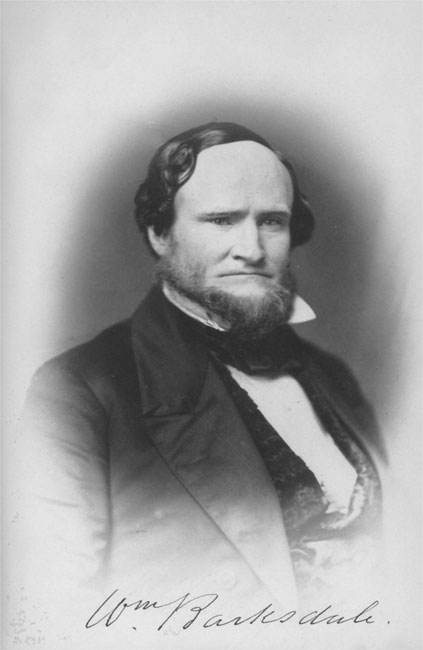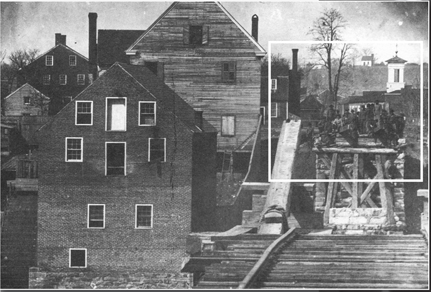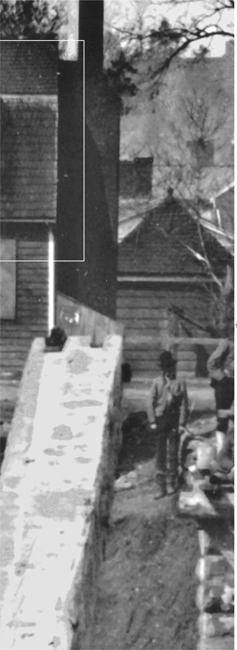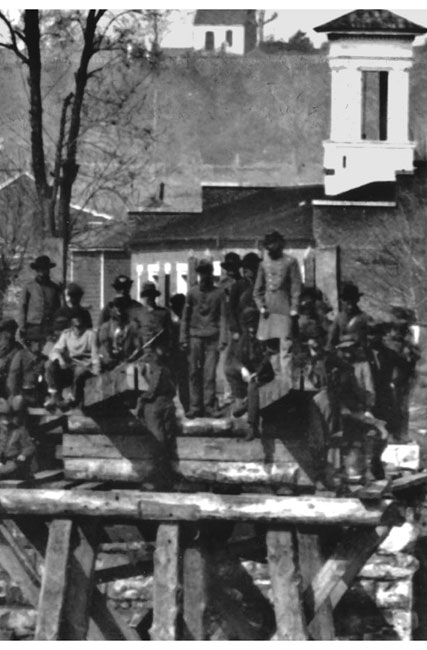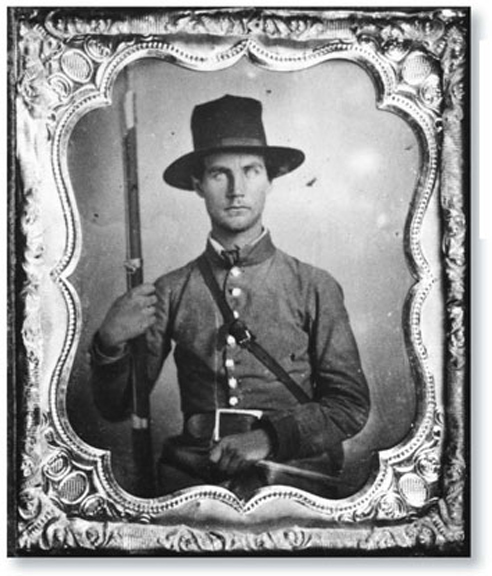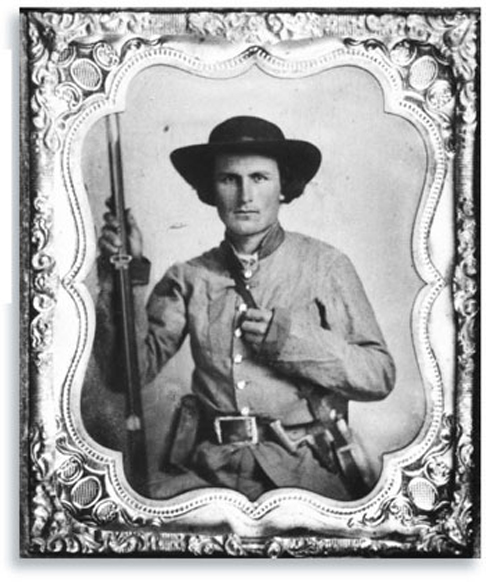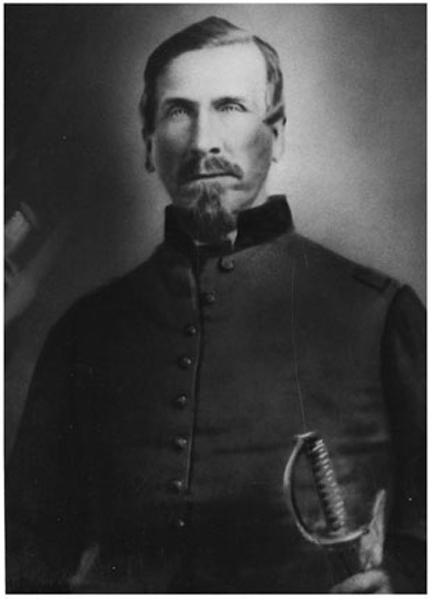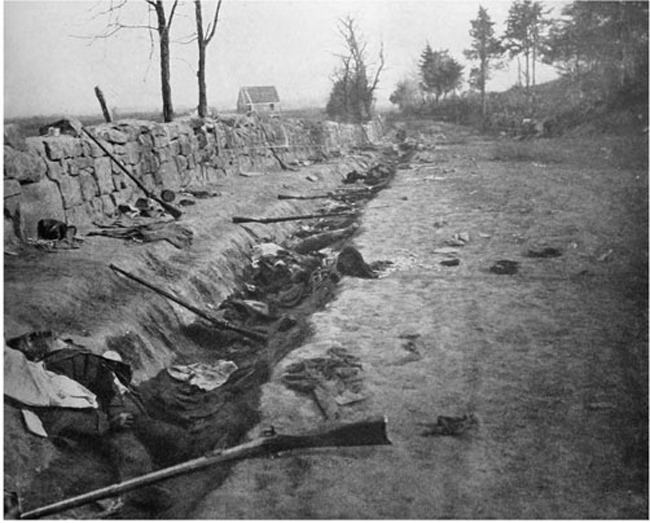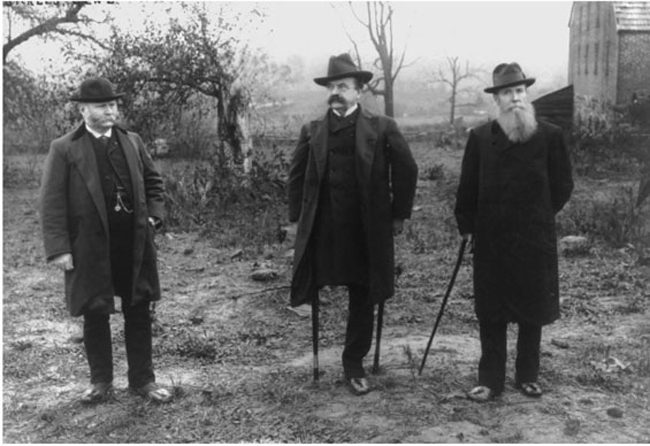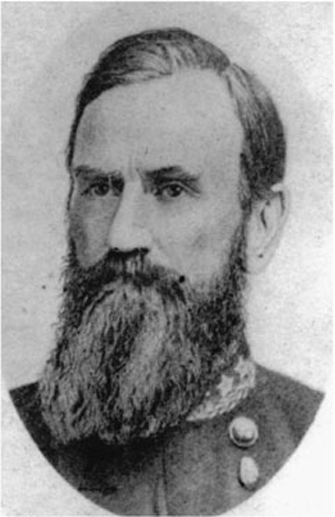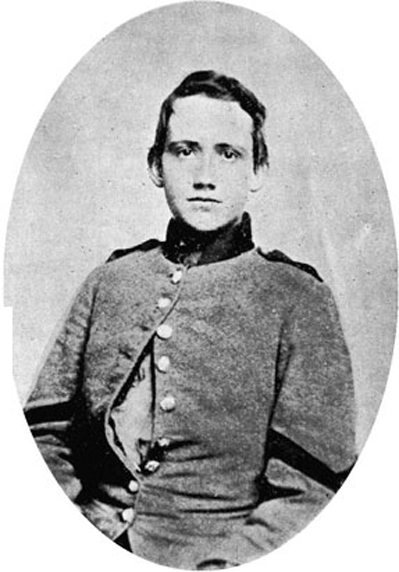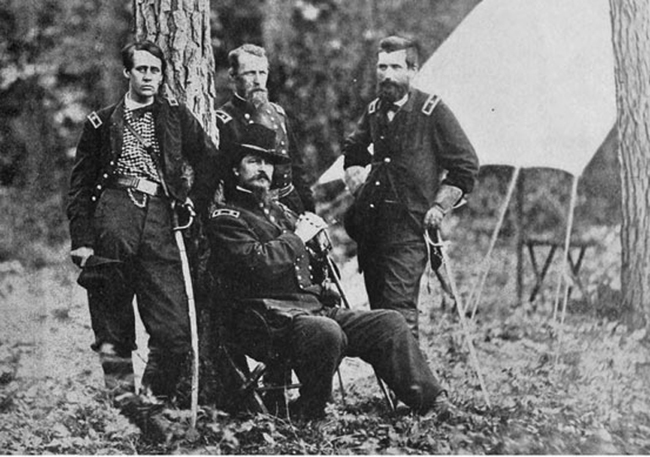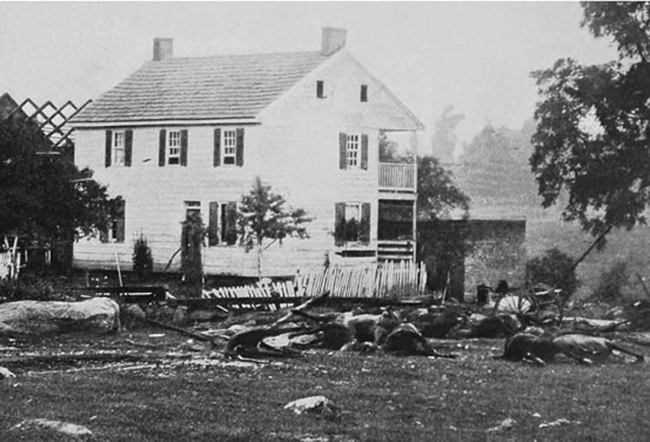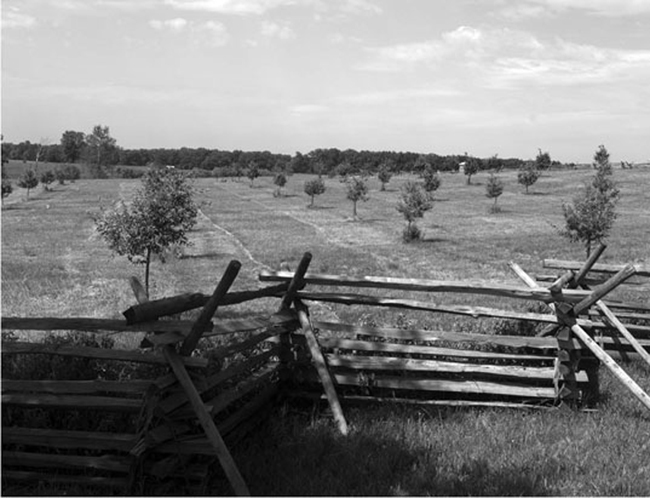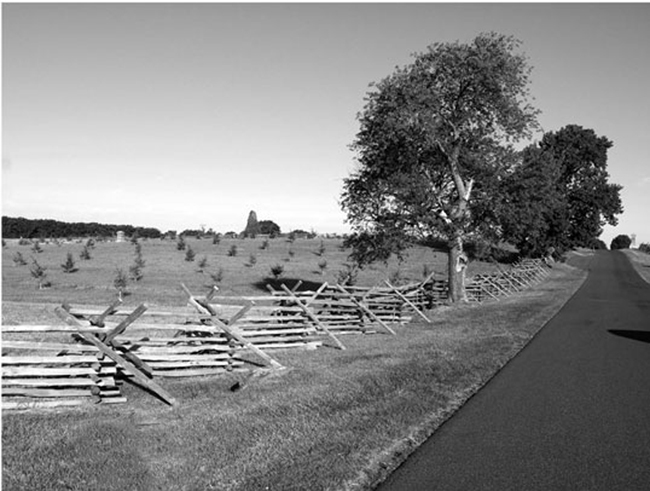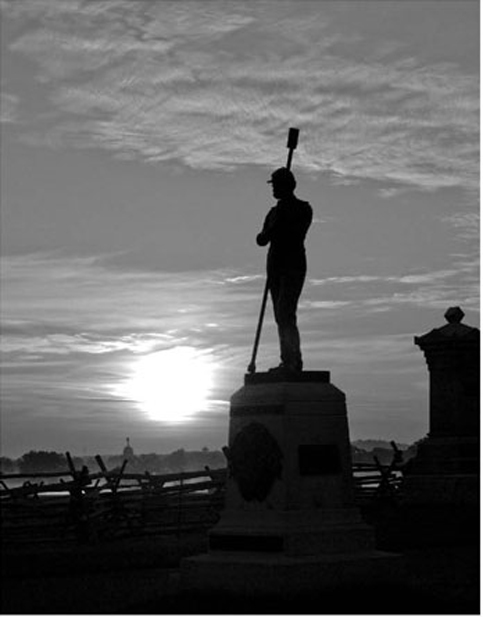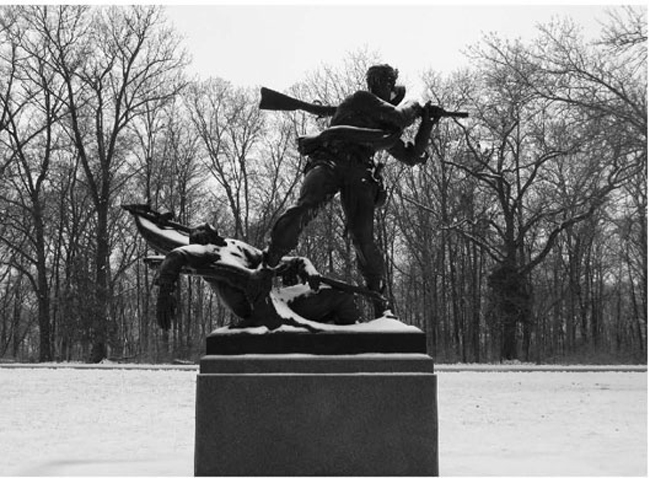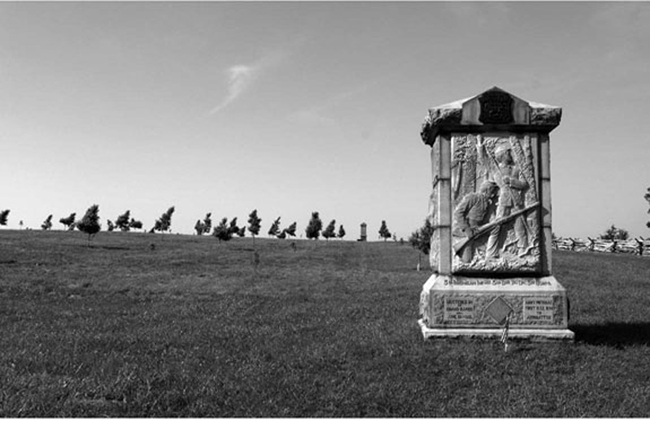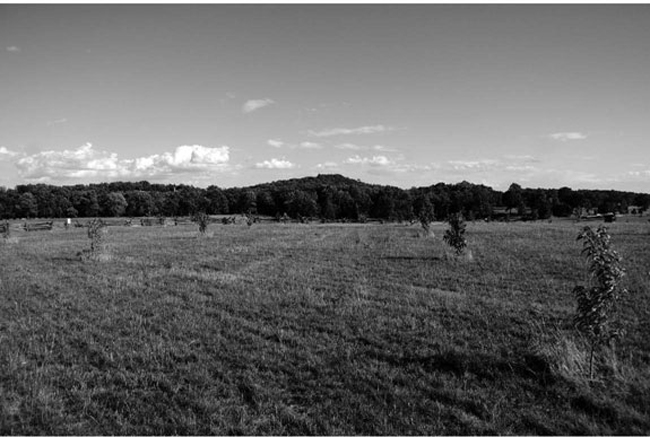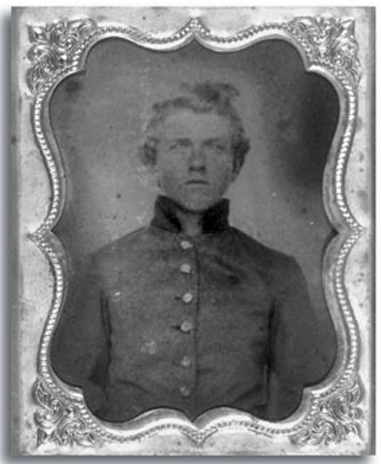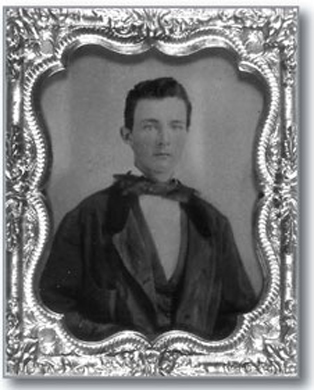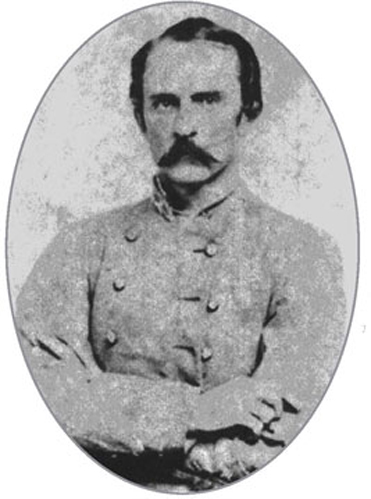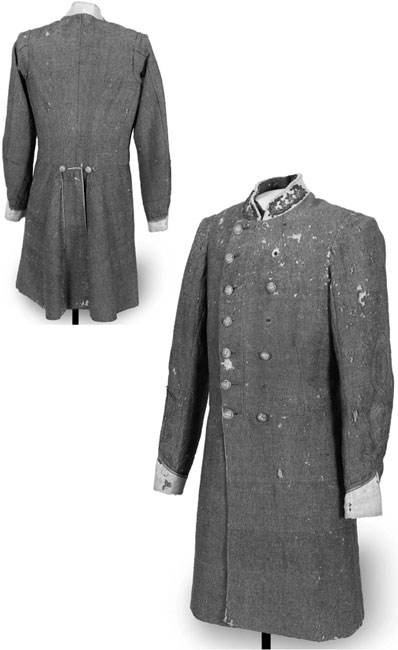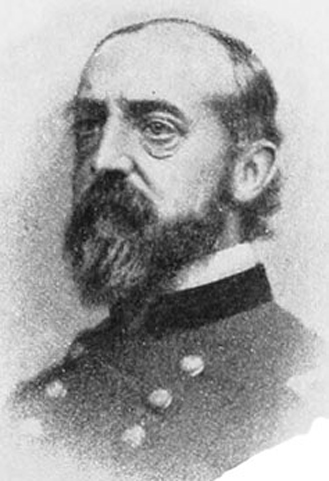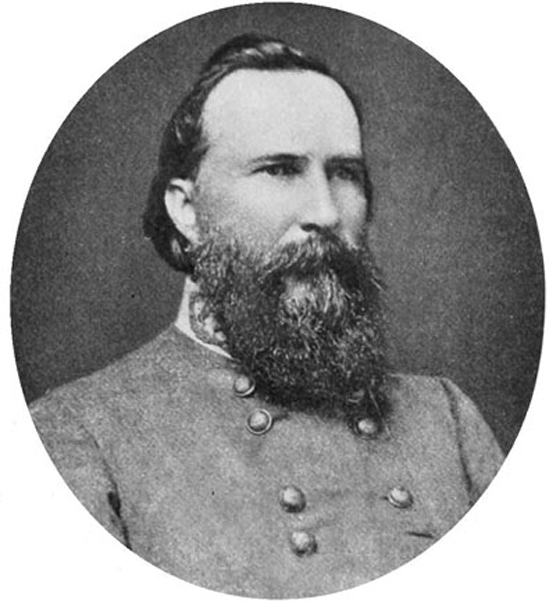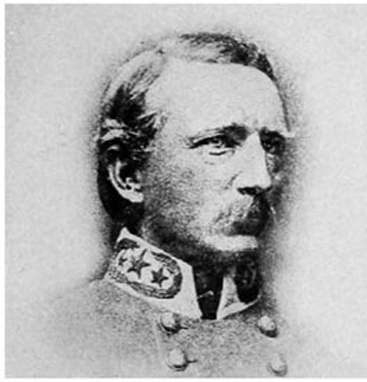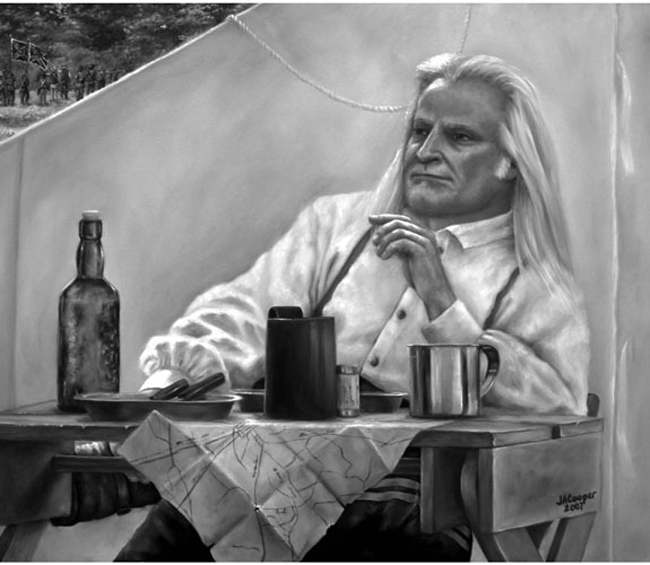
“The grandest charge ever seen by mortal man!”
LIKE BARKSDALE’S MEN, the Union soldiers holding the Peach Orchard salient had listened to the swelling tumult of battle approaching from the south. They knew their turn was coming, and as a long line of Confederates stepped out of the woods to their direct front they realized it was at hand. The men holding the salient were the First Brigade of the First Division, Third Corps, under Brigadier General Charles Graham. They were six regiments of Pennsylvania troops, who for the first time in the war were defending their home state instead of trying to invade another below the Mason-Dixon Line. Never more highly motivated than today, they yet had no way of knowing that their opponents, now in sight, were the Army of Northern Virginia’s Mississippi Brigade, men whose own home state was just then likewise being invaded, by Grant, in this most tragic and costly of American wars.
The Pennsylvania boys gave quick final checks to their rifles, then leveled them against the assembling Rebel host, still some 600 yards away. To fire too soon would be wasting a shot, then having to reload while the onslaught was nearly upon them. Fingers tensed on triggers and eyes squinted at the tree line as officers stalked up and down demanding, against natural instinct, for the men to hold their fire until ordered. Artillerists, who heretofore had been firing shell, now piled up their supplies of canister to fire like gigantic buckshot against oncoming infantry.
On the other side, at the fringe of Pitzer’s Woods, and before his lengthy formations of veterans standing at attention and not moving a muscle, “General Barksdale gave the word, and, waving his hat, led the line forward himself and we all followed him,” recalled one Confederate who never forgot the moment. As the heightened tension seemed about to burst, sharp orders rang out to “dress to the colors and forward to the foe!” With more determination to reap a decisive victory than ever before, some 1,600 men of the Mississippi Brigade surged ahead in two lengthy, parallel lines that stretched across the bright green field. To encourage his troops onward over the open ground and down the gentle eastern slope of Seminary Ridge, Barksdale continued to shout and wave his saber, imploring “Forward, men, forward!”
Captain Harris Barksdale, diminutive but every-inch a fighter, never forgot the moment when “Gen. Barksdale rode to the center of his Brigade, and in a firm voice gave the command, ’Attention, Mississippians! Battalions Forward!’ … and the line officers repeated the command ’Forward, March’.” Along a 350-yard front spanning Seminary Ridge’s eastern slope, Barksdale’s assault waves surged across the open fields of summer with red battle-flags waving.
From the Emmitsburg Road Ridge, one bluecoat described how General “Barksdale and his Brigade had to pass over a mile of open field [sic] to get to us … while he was forming his men in line of battle, the missiles from the [artillery] plowed gaps through his men, yet in battle line they stood [and prepared] to traverse the mile of open field intervening [and] when our sharp-shooters and the pickets opened fire on [and] besides the mischief done by the sharp-shooters and pickets, the [artillery] was hurling missiles of death into ranks …” Watching in awe at the Mississippians’ disciplined surge down Seminary Ridge, Long-street remembered when his high-spirited Magnolia State brigadier went into action “with glorious bearing.”217 And an Alabama soldier never forgot how the stirring sight of the Mississippians’ assault was “grand beyond description.”218
To the steady thud of beating drums and the shrill of fifes played by young, beardless musicians in gray, no regiment advanced in Barksdale’s long line with more firmness of step and resolution than the 21st Mississippi. On the brigade’s right and serving as a steady anchor for Barksdale’s assault, Colonel Humphreys described how, “the men sprang forward and sixteen hundred voices raised the famous ‘Rebel yell’ which told the next brigade, Wilcox’s Alabamians, that the Mississippians were in motion.”219
To the 21st Mississippi’s left, Private Judge D. Woodruff, Winston Guards of the 13th Mississippi, described the panoramic, wide-open arena that lay before him: “The field was clover and a gradual slope up to where the Yankee lines and batteries were about six hundred yards away.”220 Meanwhile, Mississippi drummer boys, who should have been in school, continued to beat their drums in a steady cadence as if leading a Sunday parade in Jackson rather than into the maelstrom, until it seemed that their instruments would certainly burst. Archibald H. Christy, an eighteen-year-old from Holly Springs, of Company B, 17th Mississippi, was one such musician. Despite having already been wounded at First Manassas and at Fredericksburg, Christy was now advancing in the front ranks, even though he knew would receive the brunt of the Yankees’ fire.221
By now the row of Federal guns, Bucklyn’s lethal Rhode Island pieces and a section of Thompson’s Pennsylvania Battery, that represented Pittsburgh, roared from the high ground along the Emmitsburg Road Ridge, hurling shells that smashed into the Mississippi Brigade’s ranks. One Federal defender of the Peach Orchard described how the intense concentration of artillery fire “swept gaps through them all the way across the field, and when a solid shot tore a gap in their ranks, it was instantly closed up, and the Brigade came on in almost perfect line.” Most of all, these Mississippi infantrymen felt the inspiration from what Barksdale had yelled to them just before he launched his winner-take-all attack upon the Peach Orchard: “We have never been whipped and we never can be.”222
The expert Union gunners blasted away at the lines on the open ground that could hardly be missed. Private John Saunders Henley, 17th Mississippi, described how “all their artillery [was] firing on us [but] We went in perfect line. They would knock great gaps in our line.”223 Barks-dale’s neatly aligned formations pushed stolidly forward with a well-honed steadiness that told the Yankees on the high ground that hardened veterans from the South were descending upon them in a hurry. Keeping on the move, the Mississippi Rebels ignored the exploding shells that knocked down an ever-increasing number of comrades. Clearly, the dividends of Barksdale’s longtime, seemingly obsessive focus on the importance of drill was now displayed in splendid fashion across the fields that stretched all the way to the Emmitsburg Road Ridge. Neither Union artillery fire nor the brisk firing of bluecoat skirmishers, banging away angrily and effectively, disrupted the flow of Barksdale’s advance.
Most of all knowing that his troops had to reach the Emmitsburg Road Ridge as soon as possible to avoid being shot to pieces during a methodical, textbook-like advance, Barksdale ordered his men to double-quick when yet far from their objective. Unleashing the high-pitched “Rebel Yell,” to both “inspire and terrorize,” the Mississippi soldiers raced on toward the smoke-wreathed Peach Orchard and Emmitsburg Road Ridge. Now finally unleashed with flashing bayonets that sparkled in the summer sunlight, the Mississippi soldiers neared the slight swale, located roughly halfway between Seminary Ridge and the Emmitsburg Road Ridge.
On the brigade’s right, Private McNeily, 21st Mississippi, never forgot when Colonel Humphreys gave “the ringing command-‘Double quick, Charge,’ and at top speed, yelling at the tops of their voices, without firing a shot, the brigade sped swiftly across the field and literally rushed the goal [and] our men began to drop as soon as they came to attention, and were well peppered in covering the distance with the enemy.” On the double, Barksdale’s lines poured through the fields without breaking ranks, even when exploding shells blew holes in formations. All the while, the powder-grimed Confederate gunners cheered the Mississippians’ attack by waving hats. These sweating artillerymen, shouting their lungs out, wanted Barksdale’s boys to exact bloody revenge on those lethal Union cannon, which had outmatched the inferior Rebel guns. With battle-flags flapping, Barksdale’s onrushing ranks neared the depression about mid-way between Seminary Ridge and the Emmitsburg Road.
The Mississippi veterans now felt a surge of new invigoration by having been finally “unleashed at last and eager to come to grips” with the Yankees. Leading the 21st Mississippi onward, Humphreys described how everyone “moved forward, amid the roar of cannon and the rattle of rifles [and] the work of death” was cruelly relentless to Barksdale’s attackers.224 In the 17th Mississippi’s ranks, Private John Saunders Henley described the ever-escalating momentum that could not be stopped after the “regiment began to run” toward the high ground.225
Inspiring the soldiers onward in the first rank of gray and butternut waved the brightly colored battle-flags, while Barksdale’s four regiments, the 18th, 13th, 17th, and 21st Mississippi, from left to right, surged onward. One emblem now flapping at the head of this charge was the silk banner of Company K, 18th Mississippi, which had been sewn by wives, daughters, mothers, and sisters of home communities. Presented to Company K by Miss Alice Hilzm, the Burt Rifles’ battle-flag was decorated with a colorful painting of a full blooming Magnolia tree that represented their state. The Burt Rifles’ banner contrasted with the standard Confederate battle-flags featuring a star-bedecked St. Andrews Cross.226
Due to tactical developments to the south, Barksdale’s Brigade was charging alone, without connection to any units on its right, nor yet on its left. John Bell Hood’s division, more fresh and ferocious on this day than most in the Army of Northern Virginia—for having missed Chan-cellorsville, much to its commander’s dismay—had drawn upon itself the entire Union Fifth Corps, as well as a division of the Second Corps, in addition to the troops of the Third Corps it had first attacked. In addition, part of the division had been compelled to attack up the steep citadel of Little Round Top, over unspeakable terrain that broke up formations by itself. As Federal reinforcements piled into the sector, Kershaw’s Brigade of McLaws’ Division, followed by Semmes’, had gone in to retrieve the situation. But by now the Union Sixth Corps had arrived on the field, also ready to resist the continued onslaught against the Federal left. As Hood had predicted, his attack could not succeed except at high cost. However, as Longstreet may have perceived, his initial assault had sucked in so much of Meade’s strength on his far flank that an opportunity was now presented to make the true breakthrough at the Union left-center. Not by “attacking up the Emmitsburg Road,” as Lee had mistakenly envisioned, but by striking due east, onto ground which by now had been denuded of troops save the forward array around the Peach Orchard. If that salient could be crushed, there was little behind it to prevent a breakthrough of the Federal line.
If one examines Longstreet’s offensive actions throughout the war, it’s clear that he always preferred the “one-two punch.” The classic example is Second Manassas, when Stonewall Jackson held the Union army for over a day, then Longstreet delivered the knock-out blow. This technique was perfected at Chickamauga where Polk struck first, drawing in Union reinforcements, and then Longstreet launched a gigantic battering ram that obliterated Rosecrans’ entire right wing. At the Wilderness the following spring, Longstreet arrived last on the field after Ewell and A.P. Hill had held off the Federals for a day, but then the arrival of his corps turned the tide completely, facing Grant with catastrophe in his first battle in the east, until Longstreet himself fell wounded and thus the Confederate effort dissipated.
At Gettysburg, Longstreet much rued the fact that the Confederate Second Corps was so far-flung that it could be of no help to him. In the new Third Corps he had little faith, and it had been largely used up on the first day of the fight, except for Anderson’s Division, which had formerly been under his command and would now assist. He primarily had to devise a one-two punch with his own two divisions, but that is what he essentially did. Naturally he would have preferred Hood to drive in the enemy flank before he launched McLaws. However, if Hood only succeeded in drawing the weight of Union countermeasures on himself, Longstreet could wait, and wait longer, till he saw Meade was committed. Despite Barksdale’s eagerness, he held back the Mississippi Brigade until he was certain that Meade had poured his available reinforcements into supporting his flank. Then he finally launched Barksdale against Meade’s left-center. If Barksdale could only crack the Peach Orchard salient, there would be an opportunity to sever the Federals’ entire left wing.
Meantime, Kershaw’s South Carolinians had run into trouble during the minutes before Barksdale’s launch. When Kershaw’s left wing, below and within 300 yards of the southern edge of the Peach Orchard’s salient angle, pushed northeast toward the Wheatfield Road sector, nearly perpendicular to Barksdale’s impending advance, a row of Union cannon along the road raked Kershaw’s left wing with blasts of canister, enfilading the South Carolina line. So deadly was the Federal artillery fire and so heavy were Kershaw’s casualties that the left wing’s advance, closest to Barksdale, was thwarted. Those South Carolina soldiers not killed or wounded fell to the ground to escape the artillery salvos, especially the murderous fire from the fast-working guns of the 9th Massachusetts Battery. The Palmetto Staters on the left were in a killing zone that reaped a grim harvest amid the ripe yellows stalks of the Wheatfield, while Kershaw’s right continued to attack straight east against a hotly contested feature known as the Stony Hill.
Semmes was launched to support Kershaw, thus temporarily stabilizing that situation. Hood’s four brigades still battled mightily, including in their Quixotic task of conquering Little Round Top. After the war the 15th Alabama’s Colonel William Oates, foremost in the assault, said that even if the tired remnants of his infantry had succeeded in gaining the summit, they couldn’t have held it anyway. Clearly, the hopes of the battle now rested with Barksdale, if he could only break through Sickles’ forward salient.
All the while, Barksdale led his fast-moving troops ever-closer to the flaming Peach Orchard sector now clouded in the white haze of sulfurous smoke. Despite the lack of support to its left, right or rear, the Mississippi Brigade’s attack was now, according to Noah Trudeau, “a living definition of unstoppable.”227 On through the open fields charged the Mississippians with the abandon so characteristic of elite troops in such a key situation. Around the halfway point between the two parallel ridges, the long waves of Mississippi Rebels neared the rail fence. From the ridgetop named after the Lutheran Theological Seminary, Captain Lamar, of McLaws’ staff, watched the inspiring sight of Barksdale, who was leading his fast-moving Mississippians through the killing fields: “I saw him as far as the eye could follow, still ahead of his men, leading them on.”228 Before the Mississippi Brigade’s advance, the wooden fence posed no impediment. Barksdale’s formations packed a pent-up, natural force all of its own, after having seemingly gathered momentum with each yard passed by the surging ranks.
In the rush to reach the smoke-laced crest of the Emmitsburg Road Ridge, the Mississippi Rebels continued to push onward with the Rebel Yell and a determination to gain the high ground at any cost. A Union colonel from New England standing in the Emmitsburg Road sector swore that this “was the grandest charge that was ever seen by mortal man.” Indeed, the Federal officer described with astonishment how, “nothing we could do with pickets, sharp-shooters or with cannon seemed to confuse or halt Barksdale’s veterans … nothing daunted Barksdale and his men and nothing seemed to be in their way [for they] just came on, and on, and on …”229
Indeed, the initial blue line of skirmishers, which was almost dense enough to make Barksdale’s men believe it was the first Yankee line of battle, was swept aside. Yelling louder with the exhilarating sight of the flight of so many Federals, the Mississippi veterans continued to run as fast as possible, while they closed in on the Emmitsburg Road Ridge with a renewed cheer.230 Charging with the boys of Company A, the Buena Vista Rifles, Private John Saunders Henley described how 17th Mississippi soldiers surged ahead on the “run,” after Barksdale gave the word.231
Before being brushed aside by Barksdale’s furious onslaught, the line of 5th New Jersey and 63rd Pennsylvania skirmishers had initially fought back from behind the slight shelter of a fence, a few cedar trees and scattered underbrush around the small spring at the lowest point of the slight depression. As the Yankee skirmishers had discovered the hard way, Barksdale’s countless drills month after month now paid dividends for the attacking Mississippians. A soldier recalled how, “the Magnolia State brigade sped swiftly across the field and literally rushed the goal” of the Peach Orchard, while pushing the hard-hit Federal skirmishers steadily before them as if by a giant broom.
Ignoring the hailstorm of shells and bullets dropping more good men from the ranks, the Mississippi Brigade continued to surge onward. Exploding shells wrought destruction among Barksdale’s formations, but the gaps were quickly closed-up. Meanwhile, the swiftness of Missis-sippians’ assault waves was an awe-inspiring sight not only to other Confederates but also to the Yankees. From the high ground, Sickles’ men watched the iron discipline and near perfect alignment of onrushing Barksdale’s soldiers. Private George Clark, a soldier of General Cadmus M. Wilcox’s Alabama brigade to the Mississippi Brigade’s left-rear, realized beyond a doubt that Barksdale’s onslaught was “the most magnificent charge I witnessed during the war.” And Captain Lamar, McLaws’ faithful staff officer, described how, “I had witnessed many charges marked in every way by unflinching gallantry … but I never saw anything equal the dash and heroism of the Mississippians.”
Captain Fitzgerald Ross, an “Austrian to the core” and an erudite observer with Lee’s army, recorded how Barksdale’s sweeping charge across the wide open fields “was a glorious sight [for the men] went in with a will … there was no lagging behind, no spraining of ankles on the uneven ground, no stopping to help a wounded comrade.” Mounted on his reddish-colored charger and waving his saber amid the whizzing bullets and bursting shells, Barksdale was distinguishable to one and all by his shoulder-length, prematurely gray hair streaming over his shoulders. Barksdale also wore a bright red sash around his waist. One observer watched with a mixture of awe and admiration, estimating that Barksdale was now leading his screaming Mississippi troops some fifty yards before his surging ranks. Impressed by the martial spectacle, Lieutenant Owen of the Washington Artillery described how the Mississippians’ attack “was a glorious sight.”232 Yet another fence and Yankee line of advanced skirmishers was swept away “like chaff before the wind.”233 Lamar could hardly believe his eyes, because “I was anxious to see how they would get over and around. When they reached it the fence disappeared as if by magic, and the slaughter on the other side was terrible.”234
Meanwhile, the defenders of the Peach Orchard sector were not idle while the Mississippi Brigade surged toward them. Facing the Emmitsburg Road and in support behind Lieutenant John K. Bucklyn’s Battery E, First Rhode Island Light Artillery, situated along the road just below the Abraham Trostle Lane, Graham’s brigade was aligned in the open fields. Here, they made final preparations for meeting Barksdale’s onslaught. During the nerve-wracking wait, Yankee soldiers said final prayers, recalled the lessons of bayonet practice, and braced for Barks-dale’s tempest. With lengthy ranks covering a broad front along the Emmitsburg Road, the 68th Pennsylvania anchored the left flank just south of the Wheatfield Road, the 104th Pennsylvania held the left-center amid an oat field, the 57th Pennsylvania stood on the right-center, and the 105th Pennsylvania, known as the Wildcat Regiment, was poised on the right flank, up to the Abraham Trostle Lane.235
After the Confederate artillery bombardment of two hours ceased, a flurry of adroit tactical adjustments were made by Graham to meet the Mississippians’ assault.236 On the double to confront the howling tide, fresh companies of skirmishers of the 57th Pennsylvania Volunteer Infantry advanced to the west side of the Emmitsburg Road to take possession of a better defensive position and higher terrain from which to deal punishment upon the onrushing Mississippians. On the double, a good many expert marksmen in blue also hurriedly filed into the Sherfy House, an ideal elevated shooting platform perched on commanding ground. Here, they took firing positions at the narrow windows—perfect firing slits—overlooking the open fields now filled with howling Mississippians. Situated atop a little knoll, the Sherfy House offered not only shelter from Barksdale’s onslaught but also the most elevated spot to deliver punishment over a wide area.237
While rushing toward the Emmitsburg Road Ridge, the Mississippi Rebels felt that not only the battle’s outcome but also the Confederacy’s life depended upon them. By this time, the furious Confederate assaults to the south at Little Round Top, the Devil’s Den, where one appalled Texas soldier described the bitter fighting that swirled savagely “around rocks as large as a meeting house,” and the golden stalks of the bodycovered Wheatfield of farmer George W. Rose, were meeting terrific resistance and sputtering from right to left. Despite Southern heroics and high sacrifices, all that was accomplished was a grim lengthening of casualty lists with each passing minute during what one horrified survivor called “a devil’s carnival.” The slaughter led to “Confusion [which] reigned supreme everywhere” on Lee’s battered right.238 William, “Bill,” A. Fletcher, a proud member of Hood’s hard-fighting Texas Brigade, la -mented over so many “true and tired men being shot down like dogs.”239 Consequently, as Confederate fortunes continued to flounder to the south, it was increasingly up to the Mississippi Brigade to smash through the Peach Orchard sector and reap a decisive success for the Army of Northern Virginia.240
Meanwhile, Federal defenders continued to be impressed by the grand spectacle of the Mississippians’ rush headlong into a murderous fire of Rhode Island and Pennsylvania artillery. The lithe and lean veterans kept surging ahead on the double without a pause. By this time, the Mississippi Rebels instinctively realized that their only chance for success called for getting across these broad, open fields of fire as rapidly as possible.241 Atop the Second Corps sector of Cemetery Ridge to the northeast, Captain Haskell described the dramatic showdown for possession of the Peach Orchard: “We see the long gray lines come sweeping down upon Sickles’ front …O, the din and the roar, and these thirty thousand [sic] Rebel wolf cries! What a hell is there down that valley!”242
Indeed, Barksdale’s ranks promised to pack a mighty punch and inflict devastation on the defenders in a wide swath, if the ridge could be swiftly reached.243 Barksdale’s headlong attack, in the words of Private McNeily, 21st Mississippi, was most of all a “matchless ‘rush to glory or the grave’.”244 Indeed, more than anything else, Barksdale’s all-or-nothing charge was now in essence a desperate bid to reach the commanding high ground, before too many men were cut down and the attack’s momentum was destroyed. In charging so swiftly up the gradually rising ground to the Emmitsburg Road Ridge, the Mississippi Rebels were in the process of fulfilling Barksdale’s earlier bold promise to Longstreet that he could capture the most destructive Union battery—Lieutenant Bucklyn’s six Rhode Island guns—in only five minutes once unleashed. Such a tactic was in keeping with Colonel Humphreys’ conviction that his 21st Mississippi attackers were now “determined to break the line before them, or perish.”245
All the while, Barksdale remained in advance of his troops, leading the way before his surging ranks of gray and butternut. Mounted for all to see, he continued to wave his saber, as unornate and relatively plain as his uniform, while encouraging his boys onward. The commanding figure of the forty-two-year-old Barksdale served as a shining “beacon for his brigade” during one of the greatest charges of the war.246
To escape the 21st Mississippi’s onslaught upon the suddenly strategic Peach Orchard crossroads and salient angle, the 63rd Pennsylvania, which had screened Graham’s over-extended front as skirmishes, continued to head rearward on the double, after having expended its ammunition in attempting to kill as many Mississippi Rebels as possible. Captain Harris Barksdale never forgot how his charging Mississippians “sweep the enemy’s picket line before them like chaff before a whirlwind.”247 Meanwhile, the sight of the onrushing Mississippi Brigade caused defenders to lament the absence of trenches, earthworks, or even piles of fence rails. In the words of one soldier of the 57th Volunteer Infantry, “Unlike the battlefields of Virginia where we usually fought in the woods or thickets, we were now on a field where we had an unobstructed view” of the field of strife.248
A hot fire, meanwhile, poured from the second floor windows of the Sherfy House, with sharp-eyed Yankees blasting away at Barksdale’s attack lines on the open fields. Not only from the Sherfy House, 57th Pennsylvania skirmishers around the farm’s outbuildings and trees also maintained a heavy “fire on the enemy who were within easy range.”249 However, Barksdale still resisted the temptation to halt the ranks to return fire by volley. Most of all, Barksdale knew that he had to get his troops across these open killing fields as quickly as possible. Like his comrades, therefore, a 57th Pennsylvania soldier was greatly surprised by the fact that the Mississippians “did not reply to our fire.”250
The reliable veterans of Graham’s 1,516-man brigade, with their plentiful artillery, held firm at the Peach Orchard salient and the high ground along the Emittsburg Ridge Road. The line bent at a right angle where it met the Wheatfield Road, where stood the 68th Pennsylvania under Colonel Andrew H. Tippin. No ordinary officer, Tippin was a revered hero of the Mexican War, having been the first American soldier to gain the Mexican defenses during the bloody assault at Molino de Rey outside Mexico City, on September 8, 1847. When Barksdale’s attack began, the 68th Pennsylvania’s was brought up to the Emmitsburg Road south of its junction with the Wheatfield Road, directly across from the Peach Orchard’s rows of fruit trees. To meet Barksdale’s onslaught, Graham’s four veteran Pennsylvania regiments, bolstered by Bucklyn’s Rhode Island guns and Thompson’s section of Pennsylvania artillery, were aligned along the east side of the Emmitsburg Road, holding the strategic crest of the Emmitsburg Road Ridge. Belonging to General David Bell Birney’s First Division of Sickles’ Corps, these reliable Pennsylvanians proudly wore their red diamond corps badges on blue kepis with a jaunty air, feeling a great deal of pride in themselves and their hard-fighting units.
Bracing for the Mississippians’ impact, the 57th Pennsylvania was led by a most capable commander. Colonel Peter Sides had demonstrated skill that had elevated him to lieutenant colonel from a captain’s rank back in mid-September 1862. In the war’s early days of innocence and as if yet on the farm, these Pennsylvania men had called their commanding officer “Charley” instead of colonel. But now the 57th Pennsylvania boys were tough, disciplined soldiers. Its Company K included a number of Native Americans from the once-mighty Iroquois nation. Their names, such as Levi Turkey Williams and Wooster King, reflected a distinctive Native American culture that had failed to sufficiently distance them from the ugly realities of the white man’s civil war. These mostly Seneca warriors from New York’s Allegheny Indian Reservation proved worthy of their tribe’s warrior heritage during Gettysburg’s inferno.
Even after the 57th Pennsylvania’s strength had been reduced by onefourth by the brutal ravages of bloody battles and epidemics of deadly disease, the mettle of these high-spirited men was evident when they had nearly mutinied upon receiving orders to consolidate with another unit. Like Washington’s Pennsylvania Line Continentals who mutinied in early 1781 and marched in protest on Philadelphia during America’s struggle for liberty, these boys in bue had threatened to march on Harrisburg under arms in protest. Ironically, the 57th Pennsylvania’s baptismal fire had been received on the Virginia Peninsula at the “battle of the Peach Orchard,” at Williamsburg, Virginia. And as a strange fate would have it, the 57th Pennsylvania had been positioned on the high ground at Malvern Hill when the Mississippi Brigade attacked. Then, before the year’s end, the Keystone State regiment lost more than half of its strength, including its regimental surgeon, during the suicidal attack on Freder-icksburg’s heights. And in early May 1863, another 30 percent casualties were suffered by the 57th in Chancellorsville’s dank woodlands, leaving only a relatively small-sized regiment for the showdown at the Peach Orchard.251
Nevertheless, Colonel Sides now led a well-disciplined regiment, armed mostly with .54 caliber Austrian rifled muskets. Promising to give Barksdale’s men a tough fight, the 57th had won the hard-earned reputation for reliability. These hardy soldiers now defended the northern arm of the Peach Orchard salient along the Emmitsburg Road around the Sherfy House. They were yet motivated by an inspirational example that was now part of their unit identity: their respected former commander, General Philip Kearny, whose “pet” regiment was the 57th, who had been killed at Chantilly, Virginia on September 1, 1862. Grieving 57th Pennsylvania soldiers had served as the special honorary escort that took the body of the revered Mexican-American War hero to Washington, D.C.
The 57th Pennsylvania had been under fire from Colonel Alexander’s artillery for two long hours. However, they had suffered relatively little damage. Consequently and despite having been initially positioned in the open fields on the Emmitsburg Ridge Road’s east side without shelter during the intense cannonade, the 57th Pennsylvania troops were in overall good shape. Most Rebel shells had whizzed harmlessly over the prone Pennsylvanians to explode in the open fields behind them, destroying Farmer Sherfy’s well-nurtured crops instead of Yankees. Federal infantry positioned near the targeted cannon suffered more than any others, but the overall damage inflicted on both infantry and artillery was insufficient. Even the 114th Pennsylvania, in support of Bucklyn’s Rhode Island guns, was relatively unscathed from Alexander’s bombardment.
Consequently, everything now depended on the Mississippi Brigade’s fighting prowess to punch a hole through the Peach Orchard defensive sector by the standard tactics that had long ensured bloody failure in this war: a frontal assault with the bayonet launched against a high ground defensive position held by large numbers of veterans and artillery.252 And defenders like the 57th Pennsylvania had earned the reputation as “men that won’t run.”253
To the 57th Pennsylvania’s left and deployed along the Emmitsburg Road to protect the six guns of the First Rhode Island Artillery stood the 114th Pennsylvania. Bucklyn’s six guns stood defiantly in the 150-yard open space of high ground situated between the Sherfy House and the John Wentz buildings just to the southeast and immediately north of the Wheatfield Road. While the battery’s left and center sections blasted away from good high ground firing positions between the Wentz House and the Sherfy barn, the right section fired at the attacking 18th Mississippi from a dominant, elevated position in the garden near the Sherfy House.
Holding the line near and immediately south of the Sherfy barn to protect Bucklyn’s booming guns, the 114th Pennsylvania was yet another fine regiment of Graham’s Pennsylvania brigade. Symbolically providing an indication of the close relationship existing between Union artillery and infantry, because each depended so much upon the other for mutual survival against attacking Rebels, these Pennsylvania infantrymen had rescued Captain Randolph’s guns at Fredericksburg. The memory of that timely intervention now set the stage for a comparable timely support role of these Pennsylvania infantrymen, who had been specifically chosen by Graham to support the Peach Orchard batteries.254
The 114th Pennsylvania was known collectively as Collis’ Zouaves. These Philadelphians were named for the unit’s former commander, a feisty Irish immigrant who migrated to America in 1853 and became a successful Philadelphia attorney, Colonel Charles Henry Tuckey Collis. He had been born in the busy port of Cork, nestled amid the green rolling hills of southern Ireland. Although diminutive, the handsome Irishman was pugnacious, and Collis bestowed this combativeness to his fine regiment. Consisting of enlisted members with an average age of twenty-four but also including a good many eighteen-year-olds, this Zouave Pennsylvania regiment had demonstrated its worth at Fredericksburg and Chancellorsville, where the command suffered a high percentage of loss. During its baptismal fire at Fredericksburg and after snatching the regimental colors from a dismayed flag-bearer, Colonel Collis had led a fierce counterattack to push the Rebels back, saving Captain Randolph’s Rhode Island battery and two other batteries from capture. The Irish colonel won a Congressional Medal of Honor for valor.
The 114th Pennsylvania now once again supported the New England gunners of the Rhode Island Light Artillery in yet another, but much more important, dramatic showdown. These colorfully attired 114th Pennsylvania Zouaves were mostly city boys from Philadelphia—clerks, laborers, shoemakers, and carpenters, in contrast to the mostly yeomen farmers of Barksdale’s Mississippi Brigade. Fancy Zouaves d’ Afrique uniforms were modeled after those worn by French soldiers, who had fought the fierce North African Berber tribesmen of Algeria, which had been first occupied by a colony-hungry France in 1830.255
Ironically, Collis, when a captain, and his initial command of Zouaves, an independent company known as the Zouaves d’Afrique, had nearly met Barksdale’s men at Ball’s Bluff, but they had remained in a support role when the isolated Union task force was crushed. Unfortunately for Collis’ Zouaves this afternoon, the thoroughly seasoned Mississippians were now far more lethal than in October 1861.256 Ever-mindful of their distinctiveness compared to the other “Blue Legs” in regulation uniforms, these jaunty Pennsylvania Zouaves referred to themselves as “Red Boys,” “Zoo Zoos” and the “Zoos.”257
An awed private of another Union regiment described Collis’ highspirited Zouaves in a most revealing letter: “they are beauties I tell you— but when they ’Charge bayonets’ with such a yell as Zouaves only can give, the rebels’ll skedaddle even if the greybacks have five times as many men as the red breeches have.” The Pennsylvania Zouaves’ reputation for hard fighting had preceded them, because the Rebels said “that they didn’t like to fight the Red Legs [because] they say we look like Devils and fight too hard [and] they say we try our best to kill and I think they are about right.” However, Barksdale and his Mississippi Rebels were about to destroy this myth and erode the regiment’s lofty reputation.258
No longer led by the dapper, 115-pound Colonel Collis, who was on leave, this Keystone State regiment of highly motivated Zouaves was now commanded by Cuban-born Lieutenant Colonel Frederic Fernandez Cavada. Cavada was a classic example of the forgotten Civil War among Latinos, or Hispanics, including Cubans who wore both blue and gray. Symbolizing the deep pre-English roots in America, more than 20,000 Hispanics fought on both sides. And the showdown at Gettysburg was no exception, with Latino Rebels serving mostly in Texas, Louisiana, and Florida regiments. Explaining motivations, Confederate Tejano Captain Joseph Rafael de la Garza, who died in battle in 1864, was “fighting for our country,” in his words from a letter.
Educated at an excellent school in Philadelphia, Cavada was a romantic, liberty-loving poet, the product of a Cuban father and American mother. His slave-owning family had departed Cuba when he was young, migrating to Philadelphia. A fiery Cuban nationalist, Cavada hated the autocratic rule of Spain, which governed its wealth-producing Caribbean colony with an iron hand. Lieutenant Colonel Cavada now commanded the Zouave regiment despite suffering from recurring bouts of malaria. He had acquired the deadly tropical disease when surveying a railroad line through the tropical jungles of the Isthmus of Panama. The enlightened Cuban had also served as an army engineer and on the personal staff of Major General Birney, a Philadelphia attorney who had commanded his own Zouave regiment (Twenty-third Pennsylvania Volunteer Infantry) early in the war.
In his own personal crusade to destroy slavery in a struggle that was “the cause of all humanity,” handsome Lieutenant Colonel Frederic Cavada, dark-haired and with black eyes, took command of the regiment at Chancellorsville after Colonel Collis became ill. Because of politics and anti-Latino and anti-Catholic sentiment, the easy-going Cuban faced unfair charges for his role at Fredericksburg. Knowing of Cavada’s love of liberty, President Lincoln, remitted the court martial’s unfair sentence, however. Lieutenant Colonel Cavada then took command of the Zouave regiment, eager to redeem his reputation and demonstrate the worth of his well-training fighting men.
Meanwhile, along with the 57th Pennsylvania, the 114th Pennsylvania began to advance west of the Emmitsburg Road in order to protect Bucklyn’s guns. A 114th Pennsylvania soldier described how the Zouave command advanced to the west side of the road “with alacrity and passed through and to the front of the battery.” However, these sturdy Pennsylvania blue-clads gained a more advanced position not on orders of General Graham. Instead, the Pennsylvanian’s advance across the Emmitsburg Road was born of desperation. A desperate Captain George E. Randolph, chief of the Third Corps’ artillery brigade and although wounded in the shoulder by a Mississippi skirmisher’s bullet, had ridden up to the Pennsylvanians and implored: “You boys saved this battery once before at Fredericksburg, and if you will do it again, move forward!”
Positioned on the open ridge before the Pennsylvania Brigade, Bucklyn’s Rhode Island cannoneers had suffered more damage from Alexander’s artillery fire than the infantrymen. Private Ernest Simpson was one of the battery’s early losses. He was a young, heartsick man who had lost the will to live because of a recent letter from his strict, God-fearing parents. They had refused to approve his marriage to a pretty girl of questionable reputation. Instead of remaining safely in the rear as usual as the battery’s clerk, the tortured New England gunner overly-exposed himself at the front, where he was decapitated by a shell, to his comrade’s horror but perhaps to his own relief.
Taking full responsibility for the spontaneous decision to advance the Pennsylvania Zouaves, as if taking a cue from Sickles’ own decision to shift the entire Third Corps so far before the main line without Meade’s consent or knowledge, Captain Randolph exercised independent thought and tactical flexibility. After having been unable to locate General Graham, Randolph acted on his own, displaying the kind of bold initiative that was now necessary for any hope of stopping the hardcharging Mississippi Brigade.
Without hesitation, therefore, he had ordered the Pennsylvanians forward out of a sense of desperation in an attempt to save his battery during the emergency, when the Mississippi Brigade was about to descend upon Bucklyn’s guns. Sections of the rail fences along the Emmitsburg Road had been torn down earlier by the Yankees in preparation for just such an emergency. The removal of these obstacles facilitated the lastminute movement of the two Pennsylvania regiments across the Emmitsburg Road to protect the artillery; however, the partial dismantling of the fences on both sides of the road shortly worked likewise to the Mis-sissippians’ advantage. After knocking down more of the fence and advancing, the 114th Pennsylvania hurriedly reformed across the open stretch of high ground west of the road. Why no Federals utilized any rails for defensive purposes has remained a mystery.
Nearly 400 soldiers of the 114th Pennsylvania now presented the most colorful sight on any battlefield yet seen by the Mississippians. These men wore their distinctive brass belt buckles, marked: “114 REGT. Z.D’ A. P.V” along with their fezes and fine red leggings. However, their appearance did nothing to awe the ill-clothed Mississippians, in their homespun garb. Instead, these colorful Zouave uniforms, described as “oriental,” would only draw a greater concentration of Mississippi bullets like magnets this afternoon. As if hunting game in the shadowy woodlands back home, the Mississippi boys relished nothing more than the opportunity to thoroughly punish these gaudy Yankees in their circuslike uniforms. But the Zouave’s fighting qualities could not be gauged alone by its outlandish uniforms. The 114th Pennsylvania, explained one soldier, was “as well-drilled and disciplined, as efficient and as brave a regiment as there was in the” army.259
At Chancellorsville, Graham’s brigade had launched a counterattack that stemmed the tide after the Eleventh Corps’ collapse after Stonewall Jackson’s flank attack. However, through no fault of their own, they then had been driven back in confusion during the bitter fighting around the Chancellor House. More than 400 Zouaves of the 114th Pennsylvania went into battle and 180 men were cut down. Fortunately for Barksdale’s Mississippi Rebels at this time, the Pennsylvania troops had not sufficient time to fully recover from the beating that they had suffered in Chancellorsville’s haunted forests, and now numbered only 259 men.260
As one 57th Pennsylvania bluecoat described the last-minute tactical adjustments when “the 57th and the 114th were ordered across the road where we beheld the enemy, which proved to be Barksdale’s Mississippi brigade, advancing through the fields toward us. Our regiment at once took advantage of the cover that the house, outbuildings and trees afforded and opened fire on the enemy who were within easy range, and did not reply to our fire …” Indeed, to the 57th Pennsylvania’s right and beyond, or north of the Sherfy House, the 105th Pennsylvania, whose right was aligned along the east-west running Abraham Trostle Lane and anchoring the right flank of Graham’s Keystone State brigade, also now advanced west of the road. Therefore, from left to right, the 114th, 57th, and 105th Pennsylvania Regiments were aligned in a lengthy formation stretching across the elevated area in the Sherfy House sector to meet Barksdale’s troops, who were drawing ever-closer with ear-splitting Rebel Yells. While the 105th Pennsylvania held an advanced position on commanding high ground just to the right of the Sherfy House, the 57th Pennsylvania aligned before the house and the 114th Pennsylvania occupied the ground between the house and barn farther south. From the commanding heights of the western edge of the Emmitsburg Road Ridge, the Pennsylvania soldiers now gained a full and chilling view of the onrushing Mississippi formations, whose sprawling length in double lines were marked by a good many bobbing battle-flags of bright red.
After he saw the dense blue formations of determined Philadelphia troops rising over the immediate open eastern horizon as if they had sprung from the earth’s bowels after they had advanced across the dusty road, Barksdale finally ordered his troops to unleash their first organized and concentrated volley of the day. The gray and butternut ranks exploded with an intense fire, and a sheet of flame ran down the line’s length. Barksdale’s primary target, Buckyln’s Rhode Island Battery, was cut to pieces, losing the highest number of casualties (nearly 30) than any other Third Corps Battery. Bucklyn’s horse was shot from under him. He was horrified to see that “My Battery is torn and shattered and my brave boys have gone never to return. Curse the Rebs.” And forty artillery horses were felled, making the removal of the hard-pressed Rhode Island guns more difficult in the crisis situation.
A solid sheet of musketry also thoroughly punished the Pennsylvania infantrymen for their audacity in advancing across the road. Because the 114th and 57th Pennsylvania had pushed forward with fixed bayonets to cover the inevitable withdrawal of the Rhode Island guns, this new high ground perch just west of the road only made them more vulnerable. In the words of Captain Edward R. Bowen, a wool merchant in his midtwenties from Philadelphia who eventually became the 114th Pennsylvania’s commander, the men advanced “to the Emmitsburg Road, in the face of the murderous musketry fire of the advancing enemy … reaching the road we clambered over the fence and crossed it [and moved on, while] Sherfy’s house and outbuildings intervening between us and the approaching enemy, the right of the regiment was advanced to the rear of the house. While advancing in this way our men were loading and firing as rapidly as possible, and several times pauses were made, notably as we stood on the Emmitsburg road, and corrected the alignment, which was broken by clambering over the fence. During all this time we were receiving a terrible musketry fire from the rapidly approaching enemy, and the men were falling by scores.”
The commander of Company F and a former Philadelphia saloon keeper, Captain Francis Fix, who stood beside his brother, Lieutenant Augustus, “Gus,” Fix, fell with a mortal wound, when a Mississippi bullet shattered his knee. All the while, the Pennsylvanians fired from good defensive positions across a slight, level ledge or plateau, which marked the open western edge of the Emmitsburg Road Ridge. Blasting away like well-trained veterans, Cavada’s 114th Pennsylvania poured a hot “fire out between the house and barn,” wrote Philadelphia-born diarist Sergeant Major Given, whose wife Anne Patton had sent him off to war with a kiss and the words, “Go and God be with you.”
Beloved by the men for his kind, generous nature, Lieutenant Colonel Cavada, who commanded the 114th Pennsylvania with skill this afternoon, had been earlier warned about Barksdale’s attack by Sergeant Major Given that “You [can] bet your life they are coming in full force.” Cavada attempted to stabilize his hard-hit ranks, providing inspired leadership, while the torrent of Mississippi bullets cut down Yankees in groups and made the sulfurous air sing. The Mississippians’ rolling volleys that were unleashed with a murderous accuracy caused severe damage among the finely uniformed Pennsylvania boys.
One such soldier falling to rise no more was a young Pennsylvania Quaker named Corporal Robert Kenderdine, an old Anglo-Saxon name. He had long dreaded just such a brutal “killing day” as this one in Adams County, Pennsylvania. Kenderdine had protected the beautiful regimental banner as one of the few surviving color guard members. Barksdale’s men were now so close that Sergeant Henry H. Snyder, amid the deafening noise, was shocked when he saw cheering Mississippi Rebels with fixed bayonets emerging through the dense layers of smoke, taking deliberate aim, and shooting down Corporal Kenderdine like expert hunters picking off a squirrel. But the Mississippi marksman who cut down Corporal Kenderdine, who had cast aside his Quaker pacifism to fight for his country, was almost immediately felled with a well-placed shot. Here, on this killing ground along the treeless western edge of the Emmittsburg Road Ridge, large numbers of Lieutenant Colonel Cavada’s men “were killed and wounded here in the oatfield and around Sherfy’s house and barn.”261
Meanwhile, the hard-pressed 114th Pennsylvania received some timely support when General Andrew Atchinson Humphreys, at Graham’s frantic request and Sickles’ immediate concurrence, ordered one of his favorite regiments, the 73rd New York Volunteer Infantry, known as the Second Fire Zouaves of the “Excelsior Brigade,” south from its unengaged position on his division’s left along the Emmitsburg Road.262 Having enlisted at age nineteen and destined to fall wounded during this tempestuous afternoon in hell, Lieutenant Frank E. Moran, a New York City painter who now commanded Company H, 73rd New York, described how “we moved toward the orchard at double-quick through a shower of bullets and bursting shells.”263
At this time, Moran, of Irish descent, wrote how, the “114th [Pennsylvania], stretched along the Emmetsburg [sic] road from the gate of the Sherfy house and past the barn, were hotly at work and sorely pressed [and] fearfully exposed on the crest which rises at that point, was gallantly disputing the ground with the Mississippians, who, [led] by Barksdale, came swarming up yelling like demons.”264 Meanwhile, after pushing south to the Sherfy House sector, the breathless New York soldiers, gasping for air in the intense heat, covered in sweat and dust, and coughing amid the drifting layers of smoke, aligned about thirty yards behind the 114th Pennsylvania. As fate would have it, the largest concentration of Zouaves on the Gettysburg battlefield now faced the Mississippians. After the 73rd New York troops formed “quickly in line, and the ’click, click’ of cocking muskets” rang through the sulfurous air,” alerting Barksdale’s attackers of another sweeping volley soon headed their way.265
One of the most fiery Cuban nationalists in America, like his lieutenant colonel brother Frederic, Lieutenant Adolfo Cavada, a respected member of General Humphrey’s staff, was concerned about his brother’s welfare now that he was caught in the path of Barksdale’s onslaught. He described how the “enemy’s fire slackened then came the rebel cheer sounding like a continuous yelp, nearer and nearer it came” to the Peach Orchard salient that was now at the vortex of the swirling storm.266 Meanwhile, Colonel Frederic Cavada ordered his men to stand firm and fire more rapidly.267 Colonel Cavada was determined to redeem the good name of all freedom-loving Cubans in blue, because so many of his native countrymen fought for the South. He yet lamented that these Cubans in gray had sacrificed “the broad principle of humanity to a narrow and pitiful geographic necessity,” and “I am proud of their scorn,” because he now wore the blue.268 Cavada’s regiment, along with the 57th Pennsylvania to its right, now bore the brunt of Barksdale’s attack, especially from Colonel Carter’s 13th and Colonel Griffin’s 18th Mississippi.269
Meanwhile, Barksdale had no idea that the 114th Pennsylvania Zouaves, aligned from the Sherfy House to just south of the Sherfy barn, were supported by the 73rd New York to their rear, and that his onrushing troops were about to plow into a double-line of veteran defenders.270
As ordered by Barksdale, his soldiers had actually launched their bayonet attack earlier than usual when first directed to double-quick over the open ground, but yet the firing from the ranks continued unabated by his veterans. By this time, these seasoned Mississippians were adept at the art of loading and firing on the run with a surprising degree of accuracy. Therefore, the 73rd New York was immediately greeted with a hot fire from Barksdale’s men, who suddenly emerged through the drifting smoke to shoot down a good many more Zouaves, as if this kind of slaughter was nothing more than sport. With the 114th Pennsylvania positioned to their front, the New Yorkers were unable to return a concentrated volley in reply.
By this time, the Rebels could not be stopped by the salvos of musketry and artillery vomiting forth from the Peach Orchard and the Emmitsburg Road sector. Some enterprising 57th Pennsylvania snipers, no doubt young farm boys, had even scaled cherry trees on the Sherfy property along the open ridge. These sharpshooters in blue blasted away from their lofty perches, including from the narrow windows, flanked by handcrafted wooden shutters, of the two-story Sherfy house poised on the high ground just west of the Emmitsburg Road Ridge. This steady stream of punishment from above was described by one lucky Magnolia State survivor as simply “terrible.” Meanwhile, hundreds of veteran Union defenders continued to fire from the advantage of the high ground, blasting away as if there was no tomorrow. Delighted to be defending home soil, Private Joseph S. Beaumont, Company F, 57th Pennsylvania, yelled encouragement to his fast-firing men, “Give it to them boys, we have them on our own ground!”
All the while, Barksdale’s men continued to surge ahead with abandon, even though, as one of Colonel Humphreys’ men, Private McNeily described, “at points of the defense the enemy’s infantry was covered by stone fences and farm buildings [and] their deadliest fire was at such places.” Even the Pennsylvania Federals felt a growing admiration at the rather remarkable sight of a single Confederate brigade charging without support on either side or even support troops in the rear. The 57th Pennsylvania defenders positioned before the Sherfy House were perplexed by the unusual spectacle of an isolated Confederate infantry assaulting a high ground defensive position for “there were then no rebels to the left of those [which] engaged us, and for a while we had the best of the fight owing to our sheltered position.”271
With battle-flags flapping through the smoke, the Mississippi Rebels continued to charge toward the fire-spitting ridge around the Peach Orchard and the Sherfy House, while loading and firing as fast as they could on the run with the mechanical ease and drill-book precision of seasoned veterans. Making especially colorful targets along the high ground, the 114th Pennsylvania Zouaves continued to suffer heavily. They steadily fell in bunches to the Mississippians’ fire, especially that unleashed by Colonel Carter’s 13th Mississippi, which swept Cavada’s front with a close-range volley. More good Pennsylvania fighting men, such as Ser-geant Henry C. McCarty, Company K, who had won the Kearny Cross for past heroics, were fatally cut down in the hail of Mississippi bullets.272
The severe punishment delivered by the Mississippians’ fire-spitting rifles was too much to endure at such close range, and hard-hit Federals began to break for the rear. Private John Saunders Henley, 17th Mississippi, described how he and his comrades continued “firing on them, and they ran in crowds.”273 But despite the escalating losses, most of these tough Pennsylvanians held firm, especially in defending the slightly sunken roadbed of the Emmitsburg Road and firing from behind the post-and-rail fences alongside it. A member of the Buena Vista Rifles, Henley described how a “Pennsylvania regiment was posted behind an embarkment, and they killed lots of our boys.”274
Encouraging Company F’s soldiers of the Benton Rifles onward, Lieutenant William R. Oursler was one of those “boys” of Private Henley’s 17th Mississippi who was killed “near a Negro blacksmith shop near the Peach Orchard.”275 Ironically, Lieutenant Oursler, of German descent, received his death stroke on the land of a German farmer.276 But even more ironic, the son of John and Mary Wentz, whose log farmhouse stood just north of the crossroads in the Peach Orchard, now served in one of Alexander’s batteries, Captain Osmund B. Taylor’s Virginia Artillery, that had pounded the Peach Orchard.277
Not even the remaining double line of sturdy post-and-rail fences, lining both sides of the Emmitsburg Road, slowed down the Mississippians’ onslaught. Yelping their distinctive war-cry, Barksdale’s veterans, sensing victory, simply barreled over the wooden fences without stopping or halting to realign, as if they had long drilled for this most difficult of maneuvers. Captain Harris Barksdale described how “the first heavy line is encountered; one volley from their deadly rifles, and reloading as they rush on. Onward, still Onward! Vaulting over a rail fence they encountered the second heavy line of the enemy, consisting chiefly of artillery and of gaudily-dressed Zouaves. We drove them before us.” McLaws’ staff officer, Captain Lamar, penned that when the Mississippians swarmed over the fence “the slaughter of the ’red-breeched zouaves’ on the other side was terrible!” And Private Joseph Charles Lloyd, the Kemper Legion (Company C), 13th Mississippi, recorded the extent of the Mississippi Brigade’s success at this point, for “scarcely a minute and we were at the barn and scaling the fences at the lane and right across and in among the enemy, literally running over him.”278
The fleeing Pennsylvania Zouaves, jumbled-up and never so hard hit, presented ideal targets. Private Henley described the slaughter: “You could not shoot without hitting two or three of them,” with lead balls passing through stacked-up bodies like a knife cutting through butter.279 To the 57th Pennsylvania’s right, the 105th Pennsylvania troops, after having advanced up the slope to the west side of the road with the 114th Pennsylvania and the 57th Pennsylvania, also riddled the 18th Mississippi from the advantageous high ground.280 Representing the third, or main, line, the lengthy, blue formations of veterans of the three Pennsylvania regiments blasted away with a rapid fire, but they “were now alone in battling Barksdale’s men.”281 Rolling volleys cascaded down the open slope to rake the Mississippi Rebels, knocking down more attackers. A 114th Pennsylvania soldier described the Philadelphians’ stubbornness on the Emmitsburg Road Ridge’s western edge: “Standing on elevated ground, with open fields on all sides, the steady fire of the men, as the enemy’s infantry pushed forward, was delivered with excellent effect.”282
Just before pulling out in a hurry to escape Barksdale’s onslaught, the guns of Bucklyn’s battery, situated just south of the Sherfy House, continued to roar defiance into the Mississippians’ faces. Surging ahead with his Winston County comrades, Private Judge E. Woodruff, Winstson Guards (Company A), 13th Mississippi, described how, “The Yankee battery was on top of the rise where there was a dwelling house and barn and orchard. In back of them were … other cannon firing on us. It seemed as if you could hold up your hat and catch it full of grapeshot.”283
Entire swaths of 13th Mississippi attackers were cut down by artillery salvos. Manned by expert gunners, these fast-working New England cannon unleashed double loads of canister, the infantryman’s ultimate nightmare, at close range into the cresting waves of shouting Mississippi soldiers. The 57th Pennsylvania’s defenders not only possessed the advantage of occupying the dominant terrain just west of the Emmitsburg Road, but also the fast-firing “men of the 57th who were in the house kept up a steady fire from the west windows,” blasting away with abandon from both upstairs and downstairs.
Playing a role in leading the 21st Mississippi, which struck the 350-man 68th Pennsylvania, around the dusty crossroads that suddenly had become strategic, Captain Harris Barksdale continued to encourage the attackers onward across the body-strewn Emmitsburg Road. Colonel Humphreys’ veterans quickly formed a line with well-oiled precision to unleash a more concentrated volley, wreaking even greater havoc. Then, Humphreys’ furious attack continued up the slope and past the Emmitsburg Road, with the Mississippians “literally running over” a good many stunned 68th Pennsylvania bluecoats, who hardly knew what had hit them.
In a letter, Adjutant Harman, 13th Mississippi who was charging toward Bucklyn’s blazing Rhode Island guns, described when “the center of the Brigade struck the road at or near the 1st farm house on the Emmitsburg road to the north of Sherfy’s Peach Orchard. I crossed the road just to the south of the house.” Meanwhile, to the right, the fast-moving 21st Mississippi soldiers poured deeper into the Peach Orchard with wild shouts. Humphrey’s troops gained the Peach Orchard in less time—not much longer than five minutes—than what even Barksdale believed possible, when he had earlier boasted of that distinct, but seemingly unrealistic, possibility to Longstreet. Meantime, after observing Barksdale’s attack Longstreet later wrote, “With glorious bearing he sprang to his work, overriding obstacles and dangers. Without a pause to deliver a shot, he had the battery.”
Meanwhile, on the Mississippi Brigade’s left flank to the north, Barksdale’s elated 18th Mississippi soldiers surged “forward until both parties met at or near the old barn,” which now became the eye of the raging storm on the north. Here, wrote one Southerner, “within a few feet of each other these brave men, Confederates and Federals, maintained a desperate conflict.” A disbelieving Federal colonel attempted to describe the “the carnage inflicted on us boys in Blue [but it] would be impossible to detail.”284 Another Union officer could hardly believe how Barksdale’s rapidly-firing men, who seemingly never missed a shot, “liked to have killed them all before they could get away.”285
As on no previous battlefield, the hard-hit “Red Legs”of the 114th Pennsylvania, considered one of Pennsylvania’s “star regiments,” fell in ever-greater numbers, while hundreds of Union troops were hurled rearward by Barksdale’s onslaught. These finely-uniformed city Zouaves, with clerk the most common occupation but also including “rowdies of the city,” from Philadelphia’s close-knit, insular neighborhoods, found themselves in serious trouble. Quite simply, these city boys from the “City of Brotherly Love” were no match for the young country boys, backwoodsmen, small farmers, and hunters from across Mississippi.286
On the Mississippi Brigade’s left flank and duplicating Humphreys’ hard-hitting performance on the right, Colonel Griffin’s 18th Mississippi packed a hard-hitting punch that sent the Yankees reeling. He described how, “We steadily advanced, driving the enemy before us.”287 After unleashing their last devastating pointblank volley, Barksdale’s men closed in for the kill with bayonets. With slashing sabers and jabbing bayonets, the Mississippians literally tore apart the Pennsylvania formations.288 To the south of the Griffin’s 18th and Carter’s 13th Mississippi, respectively from left to right, the hard-charging 17th Mississippi likewise inflicted considerable damage, “leaving the ground nearly covered with their dead,” wrote Private Henley of the systematic devastation of the city boys.289 As emphasized by Private Thurman Early Hendricks, a member of the Minutemen of Attala, which attacked on the 18th Mississippi’s right flank, the 13th Mississippi once again reconfirmed its hard-won reputation as the “Bloody 13th” in the close combat, including hand-to-hand.290
From his perch atop Cemetery Ridge to the northeast, Captain Haskell described the dramatic sight of the devastation wrought by Barksdale’s knock-out blow, writing how the Third Corps troops now “fight well, but it soon becomes apparent that they must be swept from the field, or perish there. It is fearful to see…. To move down and support them with other troops is out of the question. There is no alternative—the Third Corps must fight itself out of its position of destruction!”291
As on so many past battlefields, the brigade’s crack regiment, the 21st Mississippi, achieved the most significant tactical gains of any of Barkdale’s regiments, delivering the blow that collapsed the salient angle and crushed its stunned defenders. With rounding yells, a close-range fire, and jabbing bayonets, Humphreys’ troops smashed through the apex of the Third Corps’ protruding salient angle, and then continued on without stopping to rest or reload. Charging astride the Wheatfield Road which led directly to the sector’s highest ground, the knoll of the Peach Orchard, Colonel Humphreys’ regiment struck a decisive blow that overpowered and crushed the salient angle, thus beginning the process of unhinging both arms, one extending northeast along the Emmitsburg Road and the other southeast down the Wheatfield Road.
The 21st Mississippi’s left ripped into the vulnerable and exposed left, or southern, flank of the 114th Pennsylvania—a flank that hung in mid-air—while its right struck the equally exposed right of the 68th Pennsylvania, situated just south of the intersection along the Emmitsburg Road. Because of the wide gap that extended between the left of Cavada’s regiment and the 68th Pennsylvania’s right, Colonel Humphrey’s troops penetrated sufficiently deep into the Peach Orchard on the left to outflank both regiments.
The right of the 21st Mississippi, yet astride the Wheatfield Road after crossing the Emmitsburg Road, continued to maul the 68th Pennsylvania, while the 114th Pennsylvania suffered severely from a flank fire unleashed by the 21st Mississippi’s left. In essence, the 21st Mississippi smashed simultaneously into the ends of two vulnerable flanks, and then penetrated the gap. A hard-fighting 114th Pennsylvania captain, Edward R. Bowen, was amazed by the lethal effectiveness of the Mississippians’ slashing attack. He wrote with surprise how “the enemy had already advanced so quickly and in such force as to gain the road” hardly before the Pennsylvanians knew what had hit them. Sensing a dramatic victory with the smashing of the Peach Orchard angle, Colonel Humphreys encouraged his 21st Mississippi soldiers onward to exploit their significant gains without pausing. With fixed bayonets and firing on the run, these hardened veterans continued to charge thorough the choking smoky haze that made them look like ghostly devils from hell suddenly emerging to the hard-pressed boys in blue.
Colonel Andrew H. Tippin’s 68th Pennsylvania had just attempted to advance in a belated attempt to close the dangerous gap and support the battered left of the 114th Pennsylvania. But by this time it was far too late for such an adroit maneuver. The 68th Pennsylvania was thoroughly punished under the sledgehammer-like blows of the 21st Mississippi’s right. Bolstered by the 2nd New Hampshire Volunteer Infantry, Burling’s brigade, Humphreys’ Division, that had moved to its rear, after changing from front from facing south to west toward the 21st Mississippi, the 68th Pennsylvania attempted to confront the seemingly unstoppable momentum of Humphreys’ onslaught as best it could. A calm Colonel Tippin ordered his troops to hold their fire until the rampaging Mississippians were close. A concentrated volley from the 68th Pennsylvania momentarily staggered the 21st Mississippi, knocking down a good many attackers. Feeling a sense of admiration, Private McNeily described how the Yankees “fought back bravely,” standing firm for as long as they could.
Screaming orders above the guns’ deafening roar, Humphreys hurriedly formed his troops along a fence that ran along the Wheatfield Road to reorganize his ranks, allow his panting men a breather, time to reload, and provide some protection amid the open field swept with a torrent of bullets. Here, the soot-smeared veterans from companies like the Hurricane Rifles, Sunflower Guards, and Vicksburg Confederates busily reloaded and returned a devastating fire upon the New Hampshire and Pennsylvania troops from the north. One New Hampshire soldier described the vicious combat as “close, stubborn and deadly work,” which was the bloodiest in the regiment’s history.
Meanwhile, in a most timely arrival, Colonel Holder and the 17th Mississippi’s right added timely strength to the busily engaged 21st Mississippi along the fence-line now swept by 68th Pennsylvania bullets. With the 13th Mississippi and 18th Mississippi’s right and the 17th Mis-sissippi’s left driving Cavada’s Zouave regiment rearward, the 17th Mississippi’s right turned to help exploit the gap between the 114th Pennsylvania and the 68th Pennsylvania, assisting the 21st Mississippi in timely fashion. Then, the two Mississippi regiments delivered a concentrated volley on Colonel Tippin’s 68th Pennsylvania near the small log cabin, with a stone foundation (the John Wertz House) which stood on the east side of the Emmitsburg Road. This blistering fire cut down the color bearer, dropping the 68th Pennsylvania flag, the regiment’s lieutenant colonel and major, and a good many fine men.
This well coordinated, combined one-two punch and blistering flank fire delivered by the 21st Mississippi and the 17th Mississippi’s right mauled the obstinate 68th Pennsylvania, whose right flank had been turned. Under heavy pressure, Tippin had no alternative, and the 68th Pennsylvania was forced to retreat. However, this sudden withdrawal left the 350-man 2nd New Hampshire, the first unit facing south along the Wheatfield Road, under Colonel Edward L. Bailey, exposed on the right flank to the 21st Mississippi’s onslaught. After having been dispatched to support Graham, the youthful-looking Bailey said he suddenly found “myself unsupported, and the enemy steadily advancing” with piercing, high-pitched yells that echoed over the Emmitsburg Road Ridge. After capturing more prisoners, including wounded Federals who took refuge in the Wentz House cellar, Colonel Humphreys ordered his troops to charge onward through the Peach Orchard and down the slope.
Surging east and parallel to the Wheatfield Road, the 21st Mississippi’s attackers forced the outflanked 3rd Michigan Volunteer Infantry to retire and then next slammed into the 2nd New Hampshire’s exposed right flank, thanks to the retreat of the Maine and Michigan regiments. Therefore, the 2nd New Hampshire was likewise forced to withdraw. After losing nearly 200 men and faced with encirclement by Humphreys’ attackers, Bailey ordered his battered regiment rearward around 150 yards across the grassy, open ground of the eastern slope of the Emmitsburg Road Ridge to about the Peach Orchard’s center to escape the 21st Mississippi’s furious onslaught. After sending the Pennsylvanians under Colonel Tippin reeling along with Colonel Bailey’s hard-hit New Englanders, Humphreys’ 21st and the 17th Mississippi’s right then focused their full attention to their next unfortunate victim, the 114th Pennsylvania and its vulnerable left flank hanging in mid-air to the northeast.
As greater carnage swirled around him and his devastated Zouaves, Captain Bowen described how the attacking 21st Mississippi’s left and the now reunited 17th Mississippi turned to enfilade the 114th Pennsylvania from left to right, or south to north. All the while, the onrushing Mississippians busily loaded and fired with an amazing rapidity, “pouring a murderous fire on our flank, threw the left wing of the regiment on to the right in much confusion.” Keystone State soldiers like Sergeant John R. Waterhouse, a steady Company F veteran at nearly age forty with a large Philadelphia family—wife Sarah and five children—went down when two bullets smashed into his right thigh, tearing flesh and breaking bone.
The fatal combination of “the enemy advancing so rapidly and my men falling in such numbers,” wrote Captain Bowen, the regiment’s acting major, explained how the 114th Pennsylvania was all but vanquished by the hard-charging Mississippians hardly before the fight had begun. Indeed, both the 21st Mississippi and the 17th Mississippi attackers, working together effectively with business-like efficiency as on past battlefields, continued to wreck havoc on the 114th Pennsylvania’s vulnerable left flank that was even more exposed, after hurling back the 68th Pennsylvania and the 2nd New Hampshire. Throngs of defeated survivors of the two battered regiments now headed east down the slope for Cemetery Ridge to escape Barksdale’s onslaught.
Barksdale’s regiments had not achieved their gains without paying a heavy price, however. James B. Booth, Company F, 21st Mississippi, described the escalating losses that decimated Humphreys’ regiment, including President Davis’ beloved nephew. Leading the young men of the Hurricane Rifles (Company E), darkly handsome, dignified Captain Isaac D. “Stamps was killed [mortally wounded] in three feet of me [when] we were just entering the peach orchard when he was stricken down.” As a cruel fate would have it, Captain Stamps went down with a bullet through his bowels, while he was waving the ornate saber that Colonel Jefferson Davis had carried during the attack of the First Mississippi Rifles at Buena Vista. Stamps’ haunting prophecy about receiving a death stroke had been fulfilled in tragic fashion. Private Henley, 17th Mississippi described with a mixture of pride and sadness, “We went through the Peach Orchard [but] lost many” of the regiment’s best soldiers, both officers and enlisted men.
On the brigade’s right, Humphreys’ gains were growing. In the face of the 21st Mississippi’s onslaught, the two out-flanked regiments, the 68th Pennsylvania and the 2nd New Hampshire, were simply swept aside. Most important after having hurled back the two Federal regiments, Humphreys’ 21st Mississippi effectively flanked the Peach Or-chard salient and Union regiments, starting with the 114th Pennsylvania, on the left, and the 3rd Maine Volunteer Infantry (the farthest south regiment), on the 68th Pennsylvania’s left.
This gaping hole was fully exploited when Humphreys’ men charged ahead to widen the fissure in the defensive line that grew with each passing minute, collapsing Sickles’ determined bid to hold the salient’s apex like a pierced hot air balloon. Thanks to the 21st Mississippi’s hard-hitting style, the smashing of the line’s apex was the beginning of the end for Sickles, his Third Corps, and the Peach Orchard salient, resulting in a classic case of falling dominoes. Private McNeily, 21st Mississippi, recorded how the steamrolling “21st struck and flanked the Peach Orchard angle,” delivering a powerful blow that collapsed the salient as Barksdale and Humphreys had originally envisioned.
But the most extensive damage was inflicted by Humphreys’ 21st Mississippi after it surged across the Emmitsburg Road and began charging southeast along the Wheatfield Road, which was lined with a lengthy row of Union artillery. To Humphreys’ delight and making his tactical dreams come true, the Wheatfield Road now became a golden avenue of opportunity for Barksdale’s most hard-hitting regiment. After overrunning the salient angle and continuing to advance southeast over open ground beyond the body-filled Peach Orchard, the 21st Mississippi’s devastating blows continued to wreck havoc at every point. In the words of Colonel William R. Livermore, once “the apex of Sickles’ line was broken, both wings collapsed.” But this sudden collapse had required much hard fighting by both Barksdale and Humphreys in order to push aside the stubbornly defending Yankees.
All the while, the number of victims of the 21st Mississippi’s assault soared. Continuing to wreck one Federal unit after another and despite the lack of contact with Kershaw’s brigade to the right, Humphreys’ regiment reaped more success by unhinging additional Federal regiments. It is also possible at this juncture that the Union troops could see Wofford’s Brigade coming up behind the 21st Mississippi, thus enhancing their fear of being overwhelmed. Afterward, however, Wofford would veer to the right, plunging into the hell of the Wheatfield.
The significant gains achieved by the 21st Mississippi presented a host of new tactical opportunities not only for the 21st but also for the 17th Mississippi, on Humphreys’ left. Working efficiently together as an experienced team, the 21st Mississippi and the 17th Mississippi sandwiched the 68th Pennsylvania, now in a new position near the Peach Orchard’s center after it retired east, between two irresistible forces, with Colonel Carter’s men turning the 68th Pennsylvania’s right and Humphreys’ troops turning its left. After the 68th Pennsylvania and the 2nd New Hampshire were driven back, departing in haste from the bullet-swept fenceline along the Wheatfield Road to escape the punishment, the 17th Mississippi, now slightly in the left-rear of the Union regiments along the Emmitsburg Road, had turned back to face northeastward to outflank the Pennsylvanians on their left.
After inflicting extensive damage on Cavada’s Pennsylvania Zouaves, Colonel Holder’s 17th Mississippi, now facing northeast and immediately to the right of the Emmitsburg Road, slammed into the left flank and rear of the 57th Pennsylvania around the two-story Sherfy house, and then headed toward the vulnerable left flank of the 105th Pennsylvania. Both Pennsylvania regiments took a severe beating under the close-range volleys unleashed by Barksdale’s men, who proved to be experts in delivering lethal fires and at cutting even fine Union regiments to pieces.
Trying desperately to stem the howling wave of triumphant Rebels, Colonel Calvin A. Craig, who led the hard-fighting Wildcats of the 105th Pennsylvania, holding the right flank of Graham’s brigade, described the nightmare scenario: “The regiments on my immediate left (114th and 57th Pennsylvania) cluster in groups behind the brick house and adjacent out-buildings” and then retired, “leaving my left flank entirely unprotected [and the Mississippians] taking advantage of this, advanced across the Emmitsburg road, in front of the house, and immediately opened fire upon our left flank.” With bluecoats dropping around him like leaves on a windy day, Colonel Craig ordered his western Pennsylvania boys to fall back before it was too late to save themselves. One 57th Pennsylvanian explained the damage that the Mississippians inflicted on the fast-crumbling Union defensive line: “Although the angle at the peach orchard was … bravely defended by our troops there, they were at last compelled to yield ground, and by so doing the regiments along the Emmitsburg road were enfiladed and obliged to fall back also.”292 Fulfilling Barksdale’s most ambitious expectations, Humphreys’ 21st Mississippi had caved-in the salient angle, which doomed the defensive lines of blue that stretched both northeast along the Emmitsburg Road and southeast down the Wheatfield Road.293
In consequence, a fast-paced chain reaction resulted: Humphreys’ left and the 17th Mississippi had smashed into the 114th Pennsylvania’s left flank, and the 18th Mississippi hit the 57th Pennsylvania troops from the front, before the 21st Mississippi continued to attack southeast down the Wheatfield Road, after Humphreys’ regiment was reunited. Both Colonel Carter’s 13th Mississippi and Colonel Holder’s 17th Mississippi had then poured through the gap to severely punish the left flanks of the bluecoat defenders around the Sherfy House and barn, first the 114th Pennsylvania, and then the 57th Pennsylvania and next the 105th Pennsylvania, the last of Graham’s regiments on the line. Thus the surging Mississippians applied heavy pressure simultaneously from both front and flank in a deadly vise that closed ever-tighter on both sides of the boys in blue.294 Meanwhile, on the brigade’s left, Colonel Griffin’s 18th Mississippi swarmed over the Sherfy farm with victory cheers, after shooting down and bayoneting every Yankee in sight. In the words of Major Gerald, his onrushing troops steadily pushed “the enemy before us until we reached the houses with the trees on the left, the trees proved to be a peach orchard. On the end of the orchard was a barn in which a part of the enemy had taken refuge.”295
But the vicious fighting for the Emmitsburg Road was far from over, because of the double defensive line of veteran Federals in this sector: essentially a defense in-depth. After decimating and hurling the 114th Pennsylvania rearward, Major Michael Burns’ 73rd New York, to Cavada’s right-rear in support and positioned just east of the Sherfy House, prepared to receive the hard-hitting impact of the Mississippians pouring across the road and over the open crest. Hurried onward by one of Sickles’ staff officers, the 73rd New York had been hastily dispatched south just to time to watch the shocking sight of Cavada’s Zouave regiment overrun by the Rebel tide. Leading Company H, 73rd New York, Lieutenant Moran described the final flurry of resistance of Cavada’s boys along the bullet-swept ridge-top: “At last the 114th, with a parting volley in the very faces of the Mississippians, made room for us, and our regiment poured a quick and well-directed volley at the enemy, who fell in scores among the wounded and dead of the 114th.”296
With firm resolve, the New Yorkers met the surging tide of the 18th and 13th Mississippi that poured over the body-strewn crest of the Emmitsburg Ridge. However, unleashing their first fire of the day now that Cavada’s Zouave regiment had been swept away, the New Yorkers’ close-range volley knocked clumps of Mississippi boys to the ground. But the sheer momentum of Barksdale’s attack could not be stopped. With a sense of awe, Moran wrote how Barksdale’s soldiers “staggered, but closed up, and with the familiar ’Hi-yi! returned our fire and pressed forward with the savage courage of baited bulls.”297
Lieutenant Moran described the hellish turmoil in this embattled sector east of the Emmitsburg Road: “The smoke grew thicker each minute and the sound of exploding shells was deafening. Officers and men were falling every minute and on every side … Every door, window and sash of the Sherfy house was shivered to atoms. The barn close by was riddled like a sieve from base to roof, and cannon shot at every instant spilt its boards and timbers into showers of kindling-wood. A shell burst under a load of rails beside it, and whipped them through the air like straws in a whirlwind.”298
Like the 114th Pennsylvania’s decimation in its front minutes before, so the 73rd New York was now cut to pieces by the hard-charging Rebels, the 17th Mississippi attacking on their exposed left flank and the 13th and 18th Mississippi striking in front. Lieutenant George Dennen, whose twin brother had been killed at Chancellorsville less than two months earlier, went down with a mortal wound, fulfilling his dark prophesy of impending doom. Suffering the recent fate of other hard-hit Union regiments, the New York regiment’s left flank was turned, and the mauled New Yorkers retired back above, or north of, the Abraham Trostle Lane from where they had been dispatched to reinforce Graham’s troops.299 However, the stubbornness of the 73rd New York soldiers played a key role in buying time for the shattered remains of Graham’s brigade to withdraw.300
Meanwhile, in the embattled Wheatfield Road sector east of the Emmitsburg Road, Humphreys led his 21st Mississippi eastward and deeper into the heart of the shattered Peach Orchard salient in a sweeping attack. After having already retired around 150 yards further, Colonel Bailey hurriedly aligned his surviving 2nd New Hampshire troops under the brow of a slight rise near the Peach Orchard’s mid-section with Humphreys’ screaming Rebels on their heels. Colonel Bailey described the unnerving situation, with “the enemy, distant but 20 yards,” before the Second New Hampshire boys could unleash a volley.301
Indeed, nothing could stop the 21st Mississippi once unleashed with the bayonet, especially in the skilled art of flanking, which was Humphreys’ expertise. Knowing that his New Hampshire regiment now faced certain annihilation, despite being aligned with the battered 63rd Penn-sylvania, which likewise had fallen back to realign at this ad hoc second defensive position, Colonel Bailey described the pounding delivered by Humphreys’ attackers that once again outflanked the 2nd New Hampshire: “The enemy continued advancing until they reached the brow of the hill, when their left swept toward the 63rd Pennsylvania in such overwhelming numbers as to cause it to give way … I gave the order to retire” after losing nearly 200 men.302
Humphreys’ destructive task was made only slightly easier by the redeployment of the 141st Pennsylvania that had been ordered from supporting Captain Judson A. Clark’s New Jersey battery along the Wheat -field Road to the Sherfy House’s rear and behind the 68th Pennsylvania. Here, the hard-hit 141st Pennsylvania remained in position on its own, while the 68th Pennsylvania “engaged with the enemy in front of the barn, near the brick house [but when] I took this position the 68th withdrew and I was thus left alone,” wrote Colonel Henry J. Madill.303
Despite the smashing of the southwestern end of Sickles’ defensive line along the Emmitsburg Road Ridge, the bitter fighting had only begun on this bloody afternoon. By this time, the Peach Orchard, wreathed in billowing clouds of smoke and deafening noise, was the vortex of the Mississippians’ raging storm. After the broken fragments of the 57th Pennsylvania—which lost more than half its strength today, including Colonel Sides—and the 114th Pennsylvania were hurled east across the Emmitsburg Road to leave ghastly piles of dead and wounded comrades behind, the contest for possession of the Sherfy barn, house, and outbuildings was yet to be decided. Meanwhile, many 114th Pennsylvania survivors fled north up the Emmitsburg Road, while other Philadelphians retreated east through the open grain fields beyond the road.
At this crucial moment, Barksdale now realized that he could not leave the occupied strongholds on the Sherfy farm along the Emmitsburg Road in the rear of his three regiments. After all, Barksdale’s great goal was to advance all the way to Cemetery Ridge to tear through the left-center of Meade’s line. Consequently, all of these remaining Pennsylvania defenders, tenacious in defending home soil, had to be roused out of their ad hoc fortified positions just west of the road with the bayonet.
One 57th Pennsylvania soldier, who viewed the 114th Pennsylvania’s collapse to his regiment’s left, described how “when we found the [17th Mississippi] coming up the road in our rear, Captain Alanson H. Nelson, who was soon to command the regiment [after Colonel Sides fell wounded], tried to notify those in the house, and order them to fall back, but amid the noise and confusion it was impossible to make them understand the situation, and they kept on firing with abandon from the windows after the rest of the men fell back, and they were summoned to surrender by the rebels who came up the stairs in their rear.” Thirty-five-year-old Captain Nelson, whose father had been killed during the bitter nightmare that was Florida’s Second Seminole War, saw from the porch of the Sherfy House that “the enemy was in the yard in large force, not fifty feet away.” Several of Griffin’s 18th Mississippi soldiers, instead of shooting the surprised captain, yelled for the shocked father of more than a half-dozen children to surrender. Not worried about them becoming orphans, Captain Nelson decided to “never be taken prisoner as long as I could fight or run.”
Therefore he bolted in a desperate attempt to dash through the Sherfy yard to escape: “I saw at a glance that they were in a bunch, and but few of them could shoot without endangering themselves. So I thought I could run quartering past them, and possibly escape. I took the chance, and made a dive past them, then firing began. Either their aim was poor, or else I outran their shots, for they never touched me [but] as each would whizz past me it increased my efforts. There was some kind of a yard fence around the buildings, how high I do not know; what I do know is, that I did not touch it.” Not unlike the earlier sparing of Jim Duke and his friend when they tore down the picket fence as directed by Longstreet, some Mississippi Rebels may have yet recalled chivalry, even amid the slaughter, refusing to kill the bold Pennsylvania captain from Crawford County. Nelson escaped, unlike Colonel Sides and a high percentage of the 57th Pennsylvania’s officers who were cut down by Barksdale’s sharp-shooting men. The 57th Pennsylvania suffered a devastating 57.4 percent loss on bloody July 2.
A cruel fate also awaited many Yankees, including the regiment’s second in command, Major William B. Neeper, who were now surrounded by Barksdale’s attackers. Of the 59 57th Pennsylvania soldiers captured by the Mississippi Rebels, 44 were fated to die in Southern prisons, principally in the squalor of Andersonville. In addition, the revered regimental colors were nearly captured by the swarming Mississippians, after two 57th Pennsylvania color bearers were shot down.304
Overpowered by the raging tide, the 114th Pennsylvania was cut to pieces, losing nearly 50 percent of its strength during the nightmarish combat.305 As planned by Barksdale, the Mississippians’ rapid, sweeping attack—based on the concept of dashing forward over the open fields of fire at a sprint rather than advancing slowly in a parade ground-like manner (like “Pickett’s Charge”)—had paid off immensely. In fact, the Mississippi Brigade’s charge, both in front and on the left flank of Cavada’s regiment, was so swift that a good many Zouave prisoners were knocked to the ground and literally run over.306
Indeed, more 114th Pennsylvania soldiers were captured or missing than killed or wounded.307 Historians have estimated that only around 250 Yankees were captured by the Mississippi Brigade at the Peach Orchard, but in fact the total was far higher.308 This veteran Zouave regiment’s decimation was complete, after having suffered from the blistering flank fires from Holder’s 17th Mississippi while simultaneously hit in front by Carter’s 13th Mississippi. Humphrey’s scorching flank fire pouring from the northeast and into the left flank of Yankee units in and around the Emmitsburg Road also played a key role in assisting the advance of Barksdale’s other three regiments. Around 100 Zouaves were killed and wounded (13 killed or mortally wounded and another 86 wounded) in the tempest that swirled around the Sherfy House and barn, until the bodies of Cavada’s men in colorful uniforms dotted the green fields, pastures, and yards of the Sherfy farm like spring flowers on a rain-drenched morning.
The decimation of Cavada’s Pennsylvania Zouaves was thorough with the loss of nearly 170 men. Captain Bowen, soon destined to command the battered fragments of this once magnificent Zouave regiment, described the 114th Pennsylvania’s rout: “Already they were on our left and in our rear, the regiments on our left having been swept away. It seemed as though we were surrounded and could not escape capture, and many of the regiment [were] taken prisoners at this point. Only one avenue of escape was open to us, and that was up the Emmitsburg road.”309
Meanwhile, the 73rd New York Fire Zouaves fought gamely, trading volleys with the Mississippians at close range. But the New Yorkers suffered the same dismal fate as the 114th Pennsylvania, caught in a vise of close-range frontal fire, while outflanked on the left and raked by a vicious enfilade fire. Lieutenant Moran described the cruel and systematic decimation of a fine command: “Our little regiment was melting away fast in the deadly cross-fire … and closed at last in semi-circle around its riddled flag.”310 This terrible punishment was too much for any troops to endure, and the survivors of the reeling 73rd New York retired northeast through the open fields east of the Emmitsburg Road, “leaving their dead and dying” behind in the dust, blood, and gore, wrote Lieutenant Moran, a plucky Irishman who had no idea that he faced large numbers of Irish in Barksdale’s ranks, especially in Humphreys’ regiment.311
At this juncture, Humphreys’ 21st Mississippi in the Wheatfield Road sector now embarked “on one of the most memorable freelance odysseys of the entire battle,” in the words of historian Noah Andre Trudeau.312 Indeed, the 21st Mississippi, employing discipline and a hard-hitting style, now served as the tip of Barksdale’s penetrating spear, and what Humphrey continued to skillfully orchestrate was a virtuoso tactical performance second to none during the three days of fighting at Gettysburg. By overwhelming the salient angle, Humphreys’ regiment now gained the most advantageous of positions “on the left flank [of a] delectable row of Yankee cannon” neatly aligned along the defensive line spanning southeast down the Wheatfield Road: a row of dominos just waiting to be toppled over by the 21st Mississippi.313
After tearing through the apex of the Peach Orchard salient angle that unhinged the entire Third Corps’ defensive line and hurling the 63rd and the 68th Pennsylvania and the 2nd New Hampshire rearward, Colonel Humphreys and the 21st Mississippi were now fighting on their own hook and maximizing flexibility by focusing on the best targets of opportunity. The Second Day of Gettysburg’s most magnificent solo offensive effort by any Confederate regiment began with the presentation to Colonel Humphreys of an ample number of highly-lucrative targets: both the exposed right flank of additional Union infantry regiments and a lengthy row of Yankee batteries aligned along the Wheatfield Road.
Demonstrating an exceptionally high level of initiative and tactical flexibility in so quickly adapting to the confusing battlefield situation obscured by deafening noise, drifting clouds of sulfurous smoke, and chaos swirling around him, Colonel Humphreys, in his mid-fifties, now needed no orders from superiors to achieve additional gains on his own. Indeed, there was no time for the issuing of new orders or ad hoc debates about the most appropriate tactics. Therefore, like Barksdale to the north, the versatile Humphreys now relied upon sound judgments and snap tactical decisions made on the fly. Meanwhile Barksdale likewise wasted no time. At the head of his three regiments, he now prepared to charge northeast along the Emmitsburg Road on his own in the hope of smashing one exposed Union regimental left flank after another.314 Barksdale prepared his three regiments, separated from Humphrey’s free-wheeling unit, which was now fighting on its own hook to the south, onward to inflict more extensive damage and reap greater gains.315
The only attempt to mount a Union counterattack came when General Graham rose to the challenge in splendid fashion. He ordered the stabilized 68th Pennsylvania, known as Philadelphia’s Scott Legion, after it had been pushed rearward down the eastern side of the Emmitsburg Road Ridge, to stop the hard-charging 17th Mississippi. Colonel Holder’s regiment now advanced northeast below the Emmitsburg Road and toward the Sherfy House, “coming down on our right flank,” wrote one Pennsylvanian, and the 68th was quickly repulsed with almost effortless ease.316
With all bluecoat infantry pushed aside by Humphreys in the Wheatfield Road sector, the right flank of Union artillery lay vulnerable as never before. At this time, the 21st Mississippi now possessed the best opportunity to capture additional artillery pieces, both Third Corps and Artillery Reserve guns, aligned along the Wheatfield Road. Therefore, on their own, Humphreys and his men embarked on one of the most devastating of all Confederate attacks at Gettysburg and a special mission in which the main priority was “to do a little battery busting,” but on a scale unsurpassed during the three days of fighting at Gettysburg.317
Retiring northeast below the Emmitsburg Road with his battered 73rd New York, Lieutenant Moran surveyed the slaughter along the southern arm of the Peach Orchard defensive line. He described the unbelievable sight of the damage inflicted by the 21st Mississippi: “A glance to the left revealed the shattered line was retreating in separated streams” toward Cemetery Ridge.318 Colonel Humphreys’ success also relieved pressure on the hard-hit left of Kershaw’s South Carolina brigade to the right to increase the chances for greater gains in this sector below the Wheatfield Road.319
Meanwhile, Barksdale’s blows along the Emmitsburg Road were equally devastating, matching Colonel Humphrey’s ever-growing list of achievements along the Wheatfield Road. After taking the worst beating in the regiment’s history, the surviving 114th Pennsylvania Zouaves, fol-lowed not long thereafter by the battered 73rd New York, headed northeastward either up or parallel the road. And a good many Yankees fled from the Mississippians in panic and headed through the open grain fields to the east. Other Keystone State soldiers loaded and fired in stubborn defiance, while they retreated northeast in the open fields. Sergeant Edward T. Marion, age twenty-four and fated to be killed in 1864, was seriously wounded in both buttocks: perhaps a wound that caused more embarrassment than pain. But this wound partly revealed that the Mississippi Rebels were firing sufficiently low to hit targets instead of firing too high like inexperienced troops.
In desperation, meanwhile, Captain Bowen ordered the regimental colors and the “Stars and Stripes” of the 114th Pennsylvania farther rearward to prevent their capture. The battered Pennsylvanians retired northeast in an effort to seek safety among other Union regiments. With the 21st Mississippi charging southeastward with “Rebel Yells,” only the Emmitsburg Road northeastward and the open fields to the east offered escape routes from Barksdale’s attackers.”320
Atop Cemetery Ridge and looking on in horror at the Third Corps’ systematic destruction, meanwhile, Captain Haskell, the former attorney, was shocked by the sight of the surging tide of Mississippians overrunning the Peach Orchard, where the neat rows of fruit trees had long lost their white blossoms and were now consumed in swirling smoke: “The Third Corps is being overpowered—here and there its lines begin to break—the men begin to pour back to the rear in confusion—the enemy are close upon them.”321 All the while and especially in the Wheatfield Road sector, fast-thinking Union artillerymen began to prepare to get their guns out of the 21st Mississippi’s path.322
After Barksdale’s men swarmed over the Emmittsburg Road with their red regimental banners waving amid the drifting wreathes of smoke, a good many routed Federals, of both the 114th Pennsylvania and the 57th Pennsylvania, had fled into the large Sherfy barn now full of bullet holes, to seek shelter from the tide. In the 21st Mississippi’s ranks, Private Mc-Neily described the tactical situation at this time along the Emmitsburg Road Ridge: “Our left regiment, the 18th, breasted a hot fire from a large brick barn—converted into a fortress by a Zouave regiment of Graham’s brigade … The 13th and 17th swept the line between these two salient. All met with stiff resistance.”323
The general’s nephew whose diminutive size belied his outsized fighting spirit, Captain Harris Barksdale, described the extent of the Mississippi Brigade’s success. He wrote how after “the turnpike reached, and a half mile has been gained, six Napoleon guns are here taken, and at least 300 prisoners.” Meanwhile, without resting or losing momentum, the Mississippi Rebels continued to hotly press the reeling Yankees at every point, punishing those Third Corps units caught in their path.324
With the “blue-bellies” on the run as far as the eye could see and fleeing in three directions, including toward Cemetery Ridge, Barksdale now fully understood the tactical necessity of capturing the large Sherfy barn, which had become a defensive bastion held by quite a few determined 114th Pennsylvania Zouaves and 57th Pennsylvania boys, despite the cost in time that it would take in reducing it. The Mississippi Rebels now employed finely-tuned skills from hunting in Mississippi’s magnolia, oak, and pine forests and cypress swamps since boyhood and most recently sharpened in the nightmarish urban combat that had swirled through Fredericksburg’s streets last December.325
Clearly, to Barksdale’s clear tactical reasoning and at all costs, the twin strongholds—the house and barn—on the Sherfy farm had to be reduced as soon as possible. Before Barksdale’s three regiments could yet resume the attack northeast up and parallel to the Emmitsburg Road, the threat posed by a large number of Philadelphians defending the immense barn, nearly twice the size of the house, had to be reduced as soon as possible before additional gains could be reaped by continuing the assault. Such a concentration of Federals simply could not be left in the Mississippi Brigade’s rear to serve either as a rallying point for defeated bluecoats or a staging area for resurgent Yankees to strike at the Missis-sippians’ rear once Barksdale continued the advance northeast.
Consequently, the Yazoo County-born Major George Bruce Gerald prepared to take action. He was soon to command the 18th Mississippi, which advanced on the brigade’s left, because Colonel Griffin and Lieutenant Colonel William Henry Luse were shortly cut down and later captured. The resourceful Major Gerald embarked upon the task of reducing the dual strongholds that stood close to each other and well within mutual-supporting distance. On Griffin’s orders by way of Barksdale, Major Gerald, age twenty-eight, gathered a band of reliable 18th Mississippi soldiers and led them in an assault on the barn. To inspire his men, the major dashed ahead with a waving saber in the attack upon the stronghold, lit up by Pennsylvania rifle-fire in response.326
These 18th Mississippi boys were more than willing to follow their young major to hell and back if necessary. Gerald described his plan, “I called to the men that the barn must be captured and to follow me and I would open the door.”327 A tough, hard-nosed fighter throughout his life, Major Gerard was destined to kill two opponents in a classic gunfight in the streets of Waco, Texas near the turn of the century, nearly two decades before his cremated ashes were spread in the Gulf of Mexico.328 The Pennsylvania Yankees who made their defiant last stand in the Sherfy barn—one of the forgotten struggles of the battle of Gettysburg—had no idea that they were about to meet one of the 18th Mississippi’s toughest leaders in a bloody showdown.329
As Major Gerald described the attack on the blazing Sherfy barn, which stood atop the ridge beside the Emmitsburg Road like a giant red beacon now ablaze with Pennsylvania gunfire: “They followed me with a rush” to eliminate the Yankee threat. Gerald was the first to reach the barn, somehow surviving the hail of bullets that kicked up spouts of dust around him. He unhinged and began to force open the large barn door. Major Gerald then swung the door wide open, allowing his 18th Mississippi soldiers, with fixed bayonets and fierce yells, to storm into the midst of the Pennsylvania defenders inside the imposing three-story structure. In terms of width, height, and overall size, this was no ordinary barn, looking more like a giant warehouse than a typical Mississippi barn to Gerald’s Deep South soldiers.
Flashing musketry instantly erupted from inside the enclosure, dropping the first handful of 18th Mississippi Rebels who charged in. Gerald never forgot how the embattled Sherfy “barn was filled with smoke so dense that it was very nearly impossible to distinguish a man’s body in it, such a continuous fire had the enemy within kept up.” A factor not considered when the 114th Pennsylvania regiment was organized in the summer of 1861, when everyone believed that the war would be glorious and brief, was that the bright red colors of the Zouave uniforms now made excellent targets for Gerald’s men even amid the smoky haze of the Sherfy barn.330
Young men unleashed fire at point-blank range in the confined setting which looked more like night than day. But now the Mississippian’s experience in nasty urban fighting from the slick, wintry streets of Fredericksburg came to the fore against the Zouaves in early July. Major Gerald’s men used bayonets with finesse and deadly skill, jabbing and thrusting at the dark outlines of opponents in the smoky near-blackness. Doing what had to be done to gain possession of the barn as quickly as possible, Gerald’s veterans worked in business-like fashion, plunging and slashing with their sharp implements of steel. Other Mississippians swung muskets like clubs, cracking skulls and bashing the heads of fiercely resisting Pennsylvanians. Cavada’s Zouaves and the 57th Pennsylvania boys proved difficult to overcome when cornered. Amid the choking haze of sulfurous smoke and dust filling the Sherfy barn, young men from Mississippi’s small farms and Philadelphia’s cobblestone streets came to deadly grips. Soldiers fought each other like primeval animals trapped in a life-or-death struggle, grappling with each other in mortal combat. Mississippi and Pennsylvania veterans fought each other without pity or remorse, rolling in the dirt and blood, swinging fists and cursing in the confused, point-blank fighting in the dusty semi-darkness.331
The wild melee inside the Sherfy barn’s chaotic confines was brief but vicious. Major Gerald recorded how: “within less than two minutes we had killed, wounded or captured every man in the barn.” The Pennsylvanian’s tenacity in defending the Sherfy barn stemmed from coming to grips with their hated invader, defending home soil, and the belief that God was on their side: ironically, young Americans frantically fighting each other, despite from comparable classes and thinking very much alike in fundamental ways, while possessing more similarities than differences. In the end, Major Gerald and his men captured the Sherfy barn and additional prisoners, but at a stiff price. Dozens of dazed, powder-grimed Yankee prisoners were quickly hustled out of the hellish barn of farmer Sherfy and rearward by Gerald’s victors. Feeling a sense of elation, Adjutant Harman, one of Colonel Carter’s trusty 13th Mississippi officers, described in a letter the intoxicating sight: “a large number of Zouaves supposed to be as many as a Reg’t or more surrendered to us in a body at the farm house.” Although it was certainly not the complete regiment, the sight of captured Pennsylvania Yankees was exhilarating, fueling the Mississippi Rebel’s hope of winning decisive victory before the sun went down on July 2.332
Meanwhile, Barksdale led the 17th and 13th Mississippi east of the Emmitsburg Road on a wide two hundred yard front, after overrunning the open ridge-top, to eliminate threats just east of the road. Likewise Colonel Humphreys continued to lead his 21st Mississippi onward to smash into its next victim in the Wheatfield Road sector. Colonel Henry J. Madill’s 141st Pennsylvania, having been only recently positioned behind Cavada’s regiment, stood below the crest of the Emmitsburg Ridge Road, after retiring northeast from the Wheatfield Road and its ill-fated assignment to support batteries against the 21st Mississippi’s slashing attack. Positioned near the road, the regiment was now all alone after the 68th Pennsylvania had been hurled rearward. One of Madill’s soldiers described with disbelief how with a wild “yell as though all Pandemonium had broken loose,” the 21st Mississippi charged toward Madill’s isolated regiment, after the colonel watched in horror as the remains of the 3rd Maine and 3rd Michigan retired rearward in a hurry. Organized in the summer of 1862 and having suffered around 60 percent losses at Chancellorsville after launching a bayonet attack, the 141st Pennsylvania, including soldiers who had only recently recovered from Chancellorsville wounds, gamely stood ready with regimental and national flags flying to receive Humphreys’ attack.
These men had recently garrisoned the defenses of Washington, D.C., where they had grown soft. They had served less than a year, and were simply no match for Humphreys’ hardened veterans, who were about to inflict the highest percentage loss suffered by any regiment of Graham’s brigade. Unfortunately, for the 141st Pennsylvania, now on the Wheatfield Road’s north side, they stood squarely in the path of the 21st Mississippi, rolling down the open slope parallel to the Wheatfield Road. With terrific force, they tore into Madill’s exposed left flank east of the Wentz House. The 141st Pennsylvania never stood a chance, especially when men from the 17th Mississippi also came up on their right. But Humphreys’ soldiers inflicted the most damage, shooting down nearly 30 men, finely-uniformed officers and color-bearers with the first volley. In only a few minutes, more than 180 north Pennsylvania boys, including the entire color company, were cut down by the blazing 21st Mississippi rifles. Clearly, despite attacking on his own, Humphreys continued to reap dramatic gains along the southern arm of the Peach Orchard salient and on Sickles’ rapidly collapsing left wing.333
In Colonel Madill’s words that described the swift elimination of another fine Union regiment dropping by the wayside from the 21st Mississippi’s combat prowess: “The enemy, after the falling back of the Sixth-eighth, advanced to the barn. I [was] overpowered by the large numbers of the enemy. I was compelled to retire.”334
The price paid by Colonel Madill’s brave soldiers, barely 200 men of a very small regiment for attempting “alone” to exchange volleys with the Mississippians was frightfully high. Firing from higher ground and down the open eastern slope of the Emmitsburg Ridge Road to sweep the Wheatfield Road sector unmercifully with a hail of lead, Humphreys’ tried veterans aimed low to make every shot count, avoiding the rookie’s sin of overshooting. Therefore, in short order, the 141st Pennsylvania was decimated by the Mississippians’ rolling volleys and more than 150 men were cut down and all but three officers, with the unit losing more men in percentage terms (nearly 74%) than any other Third Corps regiment.335
One of the finest 141st Pennsylvania officers hit and left behind to the 21st Mississippi’s mercy was Major Israel P. Spalding, age thirty-eight. Mississippi bullets tore into one thigh and shattered his ankle, leaving the major mortally wounded on the ground. The capable major would never see his wife Ruth, who he had married in December 1852, daughter, and two sons again.336 In his final letter to his family not long before he was mowed down by the Mississippi bullets: “The enemy are now in my native state and I shall not fail in my duty to the flag we follow or disgrace the uniform I wear.” Major Spalding backed up his words with his life, courageously fighting to the very end.337
Finally, after more bitter fighting that seemed like an eternity to the sweat-stained combatants, the last close-quarter fighting around the Sherfy farm sputtered to a bloody end, after the stubborn 141st Pennsylvania had been routed and hurled rearward down the Wheatfield Road. Saddened by the loss of so many good men, Colonel Madill carried the colors rearward himself through the drifting smoke, after his color guard had been slaughtered. Often overlooked, the tenacious defensive stand made by the Federals at the Sherfy House and barn was one of the forgotten stories of the Peach Orchard’s defense that cost the Mississippians a good many fine men and officers, who could not be replaced this afternoon.
Among those Zouaves captured by the Mississippians was the 114th Pennsylvania’s commander, Lieutenant Colonel Frederic Cavada, who was left behind at one of the Sherfy outbuildings. Lieutenant Colonel Cavada, the well-liked Hispanic officer, would survive Libby Prison’s hell—along with the equally unlucky General Graham who was also about to be captured this afternoon—in Richmond. Once exchanged, Cavada served as the United States Consul in Trinidad, Cuba, from late 1864 to 1869, when he resigned to become a leading Cuban Rebel commander in the nationalist struggle against Spain. However, Cavada’s legendary luck finally ran out when he was captured by the Spanish. Despite signed petitions from Generals Grant, Birney, Meade, and Sickles to save the respected Cuban, Cavada was executed by a Spanish firing squad on a July day in 1871, eight years after the battle of Gettysburg. In his beloved city known as the “Pearl of the South,” he defiantly threw his hat into the air and shouted, “Goodbye Cuba, forever!” just before a hail of Spanish bullets ended his life, after having escaped so many Mississippi bullets at Gettysburg.
Scores of other Pennsylvania soldiers were captured by the Mississippians after the collapse of the Emmitsburg Road defensive line. Shocked by the extent of Barksdale’s sparkling success in smashing through the Peach Orchard salient, Colonel Cavada’s brother, who now served on General Humphreys’ staff, Adolfo F. Cavada, never forgot the Mississip-pians’ “diabolical cheer and yells coming on like devils incarnate.” Frederic was dehorsed by a swarm of Mississippi bullets, but was unhurt. After Cavada’s capture, the reliable Captain Bowen commanded what little remained of the 114th Pennsylvania, which had been severely man-handled.338 As a sad fate would have it, both Cavada brothers finally died not in Gettysburg’s tempest, but for the great republican dream of Cuban independence.339
The rounding up of Yankee prisoners took time, delaying the resumption of Barksdale’s’ attack northeast up the Emmitsburg Road. Another forgotten factor also caused delay. After capturing the Sherfy House and barn on a ridge now covered with dead and wounded soldiers and a large number of slaughtered artillery horses, the most opportunistic threadbare Mississippi boys reaped the harvest of the spoils of war, taking shoes, articles of clothing (the color blue made no difference), and gear from the Yankee dead. One Rebel officer exchanged a handkerchief for a sword belt from a wounded 73rd New York captain, who was escorted rearward as a prisoner and back to the Sherfy House area, where the growing mass of captives were collected. Other Rebel soldiers, famished and hungry, hunted for pieces of hardtack to gobble down. One of Barksdale’s men, Private John M. Hawthorne, Company G, 18th Mississippi, picked up and kept a photo of the brother of the mortally wounded Corporal Robert Kenderdine, who had served courageously on the 114th Pennsylvania’s color guard. The photo would be returned to the Quaker family after the war’s end.340 Meanwhile, after systematically wiping out the Pennsylvania defenders of the Sherfy House and barn, Major Gerald and his 18th Mississippi victors rejoined the brigade, taking their flank position on Barksdale’s left next to the road. “We left the barn,” in Gerald’s words, and prepared for resuming the attack northeast and toward additional Yankees and cannon.341
But one last horrific coda remained for the Peach Orchard sector and the Sherfy farm. After Barksdale’s men swept through, the Sherfy barn was accidently set on fire by exploding shells. Unable to move, some wounded Pennsylvanians went up in the flames before they could escape or be rescued. Captain Edward R. Bowen, now commanding the Zouave regiment, described the sad plight of some injured 114th Pennsylvania soldiers: “Some of the wounded sought refuge in the barn, and being too badly wounded were not able to escape from it when it was burned and perished in the flames; their identification was impossible, but their remains were recognized as members of the regiment by fragments of their distinctive uniform,” such as white leggings, baggy red pants, the fezs, etc.342
After Graham’s brigade had been mauled and swept aside, Barksdale’s considerable hard-hitting power was now turned on the Second Division, Third Corps, under General Andrew Atchinson Humphreys, a tough old army regular and Seminole War veteran, who promised to put up a stiff fight. Here, northeast of the Peach Orchard carnage stood two of General Humphreys’ brigades along the Emmitsburg Road, now crowded with the broken fragments of Graham’s vanquished Pennsylvania brigade. Meanwhile, the 21st Mississippi continued to attack on its own, sweeping through the Wheatfield Road sector with a vengeance, firing on the move, and inflicting even more damage: the methodical, destructive work more often accomplished by a brigade rather than a single regiment battling on its own hook.
But ironically, the accidental division of force—usually a fundamental sin in the art of war—into two separate wings in the midst of battle actually continued to work to the Mississippi Brigade’s advantage. Indeed, in two different directions, the Mississippi Brigade’s separate wings now advanced in two freewheeling offensive efforts that packed a lethal punch. Lucrative tactical opportunities beckoned to Barksdale on the left wing because the Emmitsburg Road led to the flanks of General Humphreys’ regiments, while the Wheatfield Road led the right wing (the 21st Mississippi) southeast to the vulnerable right flanks of Federal artillery poised farther to the south.
While Barksdale surged northeast up the Emmitsburg Road beyond the Sherfy House and toward the east-west running Abraham Trostle Lane, perpendicular to the Emmitsburg Road, with three regiments, Colonel Humphreys continued to push southeast with his crack regiment down the gently sloping ground on both sides of the Wheatfield Road. In addition, the topography also served to enhance the momentum of Barksdale’s assault up the Emmitsburg Road, because the attackers surged across open ground—an expanse of broad fields—while steamrolling along the shallow, low ridge-top free of trees and underbrush. The Emmitsburg Road Ridge was high at the Peach Orchard, but the ridge gradually leveled out and dipped slightly, and then rose again along the dusty road that led to the highest point along the open ridge at a commanding knoll upon which sat the Daniel F. Klingel House before descending toward Gettysburg. The ground around the Sherfy House was just slightly higher than the Peach Orchard, while the Klingel House knoll was higher than both the Peach Orchard and Sherfy House knolls.
The 13th, 17th, and 18th Mississippi charged northeast up, and parallel to, the Emmitsburg Road, smashing into what was left of Sickles’ already defeated units, which were knocked down like ten-pins by the rejuvenated flank attack. The first encounter was with the remnants of the retiring 73rd New York in the rear, which had been dispatched to the assistance of Graham’s men. By this time, the “Excelsior Brigade” regiment was in bad shape. The regiment had been hurled north and parallel to the road from its initial defensive position behind the 114th Pennsylvania. After having been first struck by Barksdale from the west, the seemingly ill-fated 73rd New York was now hit from the southwest by the same howling Mississippians. Limping with a wound in the right ankle, Lieutenant Moran described his regiment’s dilemma: “Our line was now in considerable disorder…. For a few minutes we were in a perfect tornado of bullets and shells from both friends and foes, the open field affording no shelter. At last the enemy came hot and hard upon us. As the centre of the 13th Mississippi passed over me, the men, firing and shrieking like the Indians … .”343
Clearly, the Emmitsburg Road offered a ready avenue for the rampaging Mississippians to roll-up the left flanks of Union regiments deployed along the road. Consequently, the 105th Pennsylvania, which had been positioned to the 57th Pennsylvania’s right along the road and with its right on Trostle Lane, was the last regiment of Graham’s brigade, holding the lonely right flank. The 105th Pennsylvania was likewise severely punished by the resurgent tide of Barksdale’s 13th, 17th, and 18th Mississippi. Indeed, after Barksdale’s troops had mauled the 114th and the 57th Pennsylvania regiments and the 73rd New York, the 105th Pennsylvania’s left flank, to the right of these routed troops at the brigade line’s northern end, was fully exposed. In horror, Colonel Craig realized the extent of the danger for “a few minutes later the 114th [Pennsylvania] fell to the rear and the 57th very soon followed, leaving my left flank entirely unprotected,” as the Mississippi Rebels continued surging northeast up the Emmitsburg Road beyond the Sherfy House and toward the colonel’s vulnerable left flank from the southwest.
This golden tactical opportunity was fully exploited by Barksdale, who just kept up the momentum and the relentless pressure. Loading and firing as fast as possible, the Magnolia State soldiers continued to pour a murderous enfilade fire into the Pennsylvanians’ exposed left flank. Watching helplessly as his fine regiment was destroyed around him, Colonel Craig described how “the enemy, taking advantage of this, advanced across the Emmitsburg road, in front of the [Sherfy] house, and immediately opened fire upon our left flank.” Loading and firing on the run, the Mississippi woodsmen, farmers and bear hunters raked the vulnerable left flank of the Pennsylvania “Wildcats” with a vengeance.
One good officer falling to the Mississippians’ blistering fire was Schuylkill County’s Lieutenant Isaac A. Dunsten, Company C, 105th Pennsylvania. He went down mortally wounded, when Mississippi bullets shattered both thighs. Despite taking heavy losses these surviving Pennsylvanians gamely held their ground, facing south and standing firm to blast away at the Mississippians, who continued to scream like banshees and surge northeast as if nothing could stop them. Sensing victory in the thick, sulfurous air, Barksdale’s soldiers continued to sweep onward like an avalanche, with bayonets flashing and red battle-flags bobbing up and down through the palls of drifting smoke. The charging 18th, 13th, and 17th Mississippi, from left to right, steadily applied pressure to the vulnerable flanks, including groups of rallied Pennsylvania men from some of Graham’s defeated units. Quickly exploiting another opportunity, Barksdale likewise directed troops to strike the 57th Pennsylvania’s rear. Hit from the left flank and rear, the 57th Pennsylvania was hurled back, because, in Sergeant Ellis Strouss’ words, the howling “Confederates were swarming in our rear.”
Before Barksdale’s onslaught, each and every new ad hoc blue line of resistance was quickly overwhelmed, crumpling under the relentless pressure and murderous fires. With many good officers cut down and acting on their own, Mississippi men in the enlisted ranks often took over, encouraging their comrades onward into the swirling smoke. Here, the battered survivors, mostly Scots-Irish boys, of the notoriously tough Wildcat Regiment discovered to their dismay that the Mississippi Rebels in ragged, dirty butternut jean uniforms were the real wildcats at Gettysburg. Colonel Craig attempted to save what little remained of his badly mauled 105th Pennsylvania, “being so small and both flanks being entirely unprotected, I ordered the regiment to retire” to the rear to escape.344
After having been smashed by the hard-hitting team of Barksdale-Humphreys, the rout of Graham’s once proud brigade of more than 1,500 veteran Pennsylvania troops, who lost 740 men, was thorough. All that remained of the Federal unit were scattered knots of rallied Penn-sylvanians, yet stubborn and defiant, turning to fire at their tormentors, while they retreated to escape. With the loss of leading officers, battered Union regiments were left to largely fend for themselves, forced to make the best out of a bad situation in the face of Barksdale’s sweeping onslaught that now had a life of its own.
Private McNeily, of the Hurricane Rifles, 21st Mississippi, described the extent of the damage when the Union “retreat became a rout in which our men took a heavy toll for the losses inflicted on them.”345 Indeed, the collapse of Graham’s brigade and other regiments of Birney’s First Division in attempting to defend the Peach Orchard now “meant real trouble for [General] Humphreys, who faced an aggressive enemy flushed with victory on his right and rear, with all the signs in his front indicating that a serious attack [from Wilcox’s Alabamians] was coming there next.”346 Therefore, General Humphreys desperately sought to protect his heavily pressured left as best he could, after he discovered to his horror that there was “nobody [now left] but myself—Birney’s troops cleared out.”347
Knowing the importance of keeping up the momentum and initiative, the elated Mississippi troops continued to surge up the Emmitsburg Road with Rebel Yells. With Barksdale leading the way as usual, the 13th, 17th and 18th Mississippi, from right to left, tore savagely into those reinforcing units that supported Graham’s mauled brigade, consisting of Colonel William R. Brewster’s Second Brigade, Second Division, Third Corps. Urged onward by Barksdale, the Magnolia State brigade’s fast-moving left wing charged Colonel Brewster’s famed brigade. Bestowed with the proud name “Excelsior,” the Latin motto of the State of New York, the Second Brigade, Humphreys’ Second Division, Third Corps, of more than 1,800 tough New Yorkers was positioned just beyond, or north of, Trostle Lane and east of the Emmitsburg Road to pose a threat to Barksdale’s right flank. Commanded by the relatively inexperienced Brewster, these New Yorkers were part of a dual defensive line that had been positioned to the right-rear of the 105th Pennsylvania on the road’s east side and directly in the path of Barks-dale’s regiments attacking below the road.
Raised by Sickles and Graham, the ambitious engineer of the Brooklyn Navy Yard who had recruited many workers from the dry docks of the naval facility, the famous “Excelsior” Brigade was a premier combat unit. The brigade consisted of the 70th, 71st, 72nd, 73rd (whose battered remains had rejoined the brigade), 74th Volunteer Infantry, which included a good many dockworkers of Graham’s old regiment whom he had commanded since the Peninsula Campaign, and the 120th New York Volunteer Infantry, which had been organized by Sickles at the war’s beginning. These New York regiments were composed of a good many Irish, Germans, and soldiers of old New York Dutch descent like Sickles, whose ancestors were the Van Sickelns from Holland. So many Irish served in the 74th New York that its chaplain was Father Joseph O’Hagen. He was a devout and respected Jesuit in blue, who fortified the enlisted men’s resolve for meeting Mississippi Rebels this afternoon.
Without losing momentum, Barksdale’s attackers tore into the left flank of Colonel Brewster’s New York brigade around 6:30 PM. They once again delivered a punishing blow, despite Humphreys, who one Pennsylvania fifer referred to a “Goggle-eyes,” having ordered Brewer’s brigade to turn left from facing west to the southwest to meet Barksdale’s threat. To their destructive delight, the Mississippi woodsmen, frontiersmen, and yeomen farmers made the most of another chance to vanquish yet another respected unit of highly touted Zouaves in one afternoon, after the 114th Pennsylvania and 73 rd New York. With tattered battle-flags waving in the swirling clouds of dust and smoke, the Magnolia Staters slammed hard into the New York brigade’s left flank. Musketry erupting from Empire State formations dropped additional Mississippi boys, but Barksdale’s attack never faltered or lost steam. More falling comrades only fueled the determination of Barksdale’s soldiers to charge onward and inflict more damage this afternoon.
Swathes of New Yorkers went down when struck from three sides by the blistering musketry erupting from the swarming Mississippians, firing on the run and making their shots count. Taking their worst punishment to date in a hard-fought sector that had become a hornet’s nest, the New York troops began to waver under the pounding. Two entire regiments, facing southwest, the 71st and 72nd New York, were quickly pushed aside. Thoroughly punished, larger numbers of the foremost New Yorkers on the left fell back northeast up and parallel to the Emmitsburg Road. While a good many New York soldiers fled in panic with cries of “Run boys, we’re whipped,” others withdrew more stubbornly through the pelting hail of Mississippi bullets. By a narrow margin, the “Excelsior Brigade” troops fought their way out of Barksdale’s tightening trap to narrowly escape their tormenters, who were determined to bag even more Zouaves to add to the day’s already impressive total of nearly 1,000 prisoners. Throughout this bloody afternoon, Barksdale’s attackers seemed to harbor a special grudge toward the colorfully uniformed Zouaves, inflicting terrible damage on the most splendid-looking troops at Gettysburg. After all, the Zouaves had long boasted of vanquishing large numbers of Rebels across the South. And Barksdale’s men were now determined to set the record straight.
Indeed, the Mississippi hellions were proving to be a nightmarecome-true for the hard-hit Zouaves. Colonel Brewer’s old regiment, the 73rd New York lost 162 men out of 350. This was a bad day for the “Second Fire Zouaves,” after their fateful second bloody meeting with Barksdale’s boys. Eliminating the threat of Barksdale’s right flank, the mauling and hurling back of the “Excelsior Brigade” opened the way for Barksdale and his rampaging Mississippians to achieve even greater gains.
But the “Excelsior Brigade’s” defeat was not just the destructive work of Barksdale’s men. To the left of the Mississippians. General Wilcox’s Alabama brigade of General Richard H. Anderson’s Division had finally advanced, sending destructive volleys into the right of Brewster’s brigade from the northwest, while the Mississippians blasted away from the southwest. Therefore, Humphreys’ two brigades fought at right angles to each other, with Brewster facing southwest and most of Carr’s brigade, on Brewster’s right along the Emmitsburg Road, facing west. In a futile effort to hold the south-facing line, a desperate Brewster had bought some precious time when he wisely formed the 120th New York Volunteer Infantry, which had been placed in reserve, at a right angle to his wavering line along the Emmitsburg Road. Behind a low stone wall that provided some protection, the New Yorkers of the 383-man regiment under Lieutenant Colonel Cornelous D. Westbrook, who fell wounded, made a determined stand amid the killing fields. Here, while the regiment was “shot apart,” they bought time for other brigade members to escape.
But Barksdale was not to be denied this afternoon, especially when the 120th New York was left isolated and alone, after the other “Excelsior Brigade” regiments had fled before the Mississippians’ attack. A close-range New York volley halted the Rebels, who quickly realigned and then returned a volley “when within a few yards of us,” wrote an astounded Charles Santvoord. But Colonel Westbrook’s defiant regiment, with its front struck by Barksdale and the right pressured by Wilcox, never had a chance All “Excelsior Brigade” troops, including even the stubborn 120th New York boys, finally retired at around 7:00 PM. The 120th New York left more than 200 fallen comrades behind after they were pushed rearward up the road toward Gettysburg.348
Private John Saunders Henley, of the 17th Mississippi, described Barksdale’s slashing attack northeastward that knocked back hundreds of Union troops, “who jumped out of the Emmitsburg road in front of the charge [and these] were several regiments of troops from New York. They ran three or four deep.”349 Clearly, the combined effect of highpitched Rebel Yells, sharpened bayonets, and expert marksmanship were not only lethal but also terrifying to a good many boys in blue. But these fears were well warranted, because the “Excelsior Brigade” lost 778 men, a more than a 42% loss. One of General Humphreys’ aide-de-camps never forgot how the Mississippians’ charge was distinguished by a “roar and a cheer” from the elated attackers, who were “coming on like devils incarnate” and destroying everything before them.350
But the price of reaping one victory after another proved terribly high for Barksdale’s left wing attackers. When a captured Lieutenant Moran, “Excelsior Brigade,” was escorted back to the Sherfy House sector, he was appalled by the scene of slaughter. He saw the farm “strewn with killed and wounded [Mississippians], mixed with a number of our own men. Many of the wounded, friend and foe, had sought refuge in Sherfy’s barn, which was riddled with shot and shell. Around it, as well as on the slope in its front, up which the Mississippi Brigade had advanced in the face of an incessant fire of musketry and artillery, the dead encumbered the ground.”351 These dead and dying young men and boys included some of the Mississippi Brigade’s best and brightest, lying mangled and broken in the gory fields.
